Lincoln Electric VANTAGE 400 User Manual
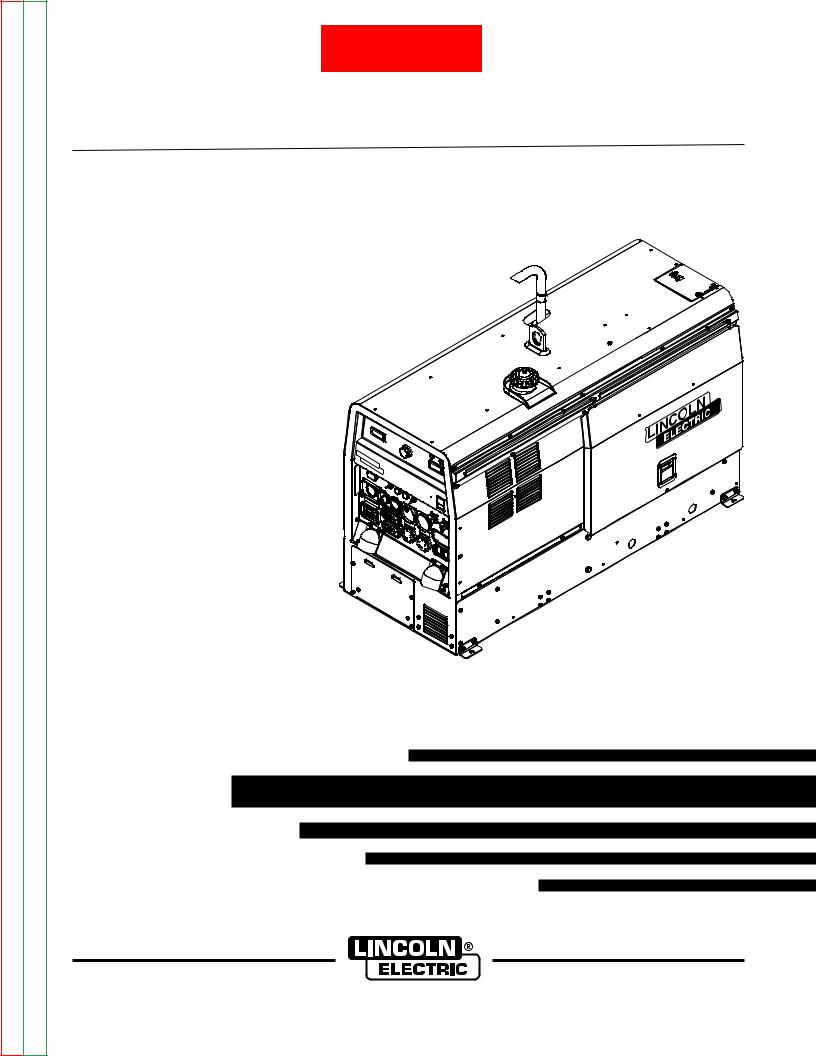
Return to Master TOC |
View Safety Info |
Return to Master TOC |
View Safety Info |
Return to Master TOC |
View Safety Info |
RETURN TO MAIN MENU
SVM182-A
April, 2011
VANTAGE® 400
For use with machines having Code Numbers: 11186, 11462
Safety Depends on You
Lincoln arc welding and cutting equipment is designed and built with safety in mind. However, your overall safety can be increased by proper installation
... and thoughtful operation on your part. DO NOT INSTALL, OPERATE OR REPAIR THIS EQUIPMENT WITHOUT READING THIS MANUAL AND THE SAFETY PRECAUTIONS CONTAINED THROUGHOUT. And, most importantly, think before you act and be careful.
LINCOLN
ELECTRIC
VANTAGE |
400 |
|
Return to Master TOC |
View Safety Info |
SERVICE MANUAL
Copyright © Lincoln Global Inc.
•World's Leader in Welding and Cutting Products •
•Sales and Service through Subsidiaries and Distributors Worldwide •
Cleveland, Ohio 44117-1199 U.S.A. TEL: 888.935.3877 FAX: 216.486.1751 WEB SITE: www.lincolnelectric.com
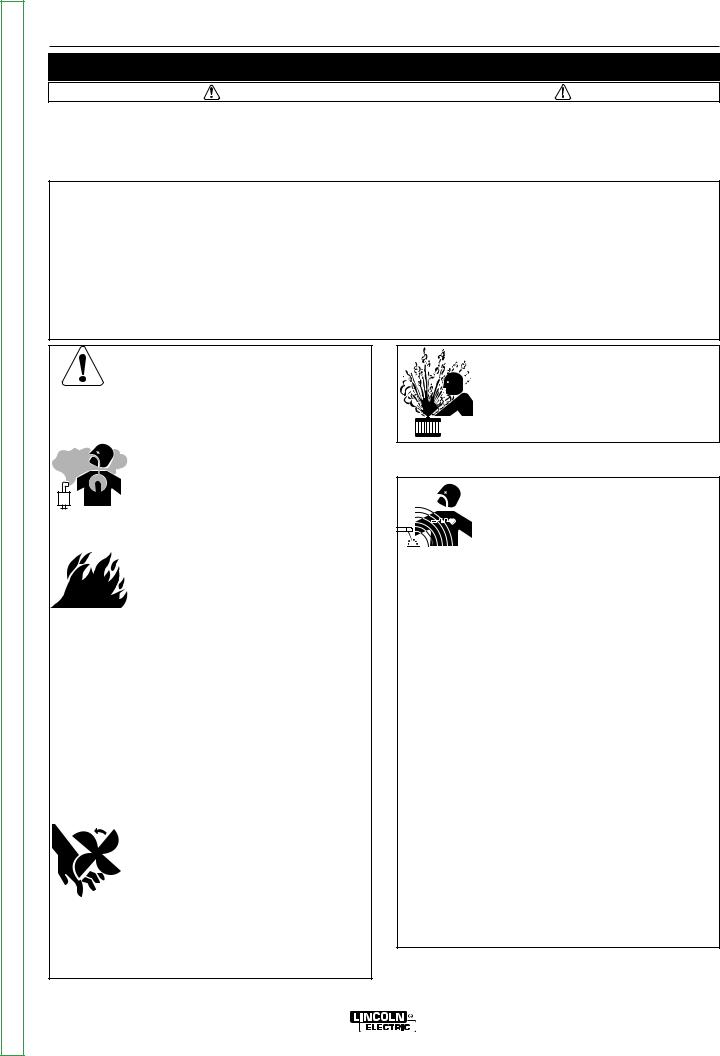
Return to Master TOC
Return to Master TOC
Return to Master TOC
Return to Master TOC
i |
SAFETY |
i |
|
 WARNING
WARNING
CALIFORNIA PROPOSITION 65 WARNINGS
Diesel engine exhaust and some of its constituents |
|
The engine exhaust from this product contains |
are known to the State of California to cause can- |
|
chemicals known to the State of California to cause |
cer, birth defects, and other reproductive harm. |
|
cancer, birth defects, or other reproductive harm. |
|
|
|
The Above For Diesel Engines |
|
The Above For Gasoline Engines |
ARC WELDING can be hazardous. PROTECT YOURSELF AND OTHERS FROM POSSIBLE SERIOUS INJURY OR DEATH. KEEP CHILDREN AWAY. PACEMAKER WEARERS SHOULD CONSULT WITH THEIR DOCTOR BEFORE OPERATING.
Read and understand the following safety highlights. For additional safety information, it is strongly recommended that you purchase a copy of “Safety in Welding & Cutting - ANSI Standard Z49.1” from the American Welding Society, P.O. Box 351040, Miami, Florida 33135 or CSA Standard W117.2-1974. A Free copy of “Arc Welding Safety” booklet E205 is available from the Lincoln Electric Company, 22801 St. Clair Avenue, Cleveland, Ohio 44117-1199.
BE SURE THAT ALL INSTALLATION, OPERATION, MAINTENANCE AND REPAIR PROCEDURES ARE PERFORMED ONLY BY QUALIFIED INDIVIDUALS.
FOR ENGINE powered equipment.
1.a. Turn the engine off before troubleshooting and maintenance work unless the maintenance work requires it to be running.
____________________________________________________
1.b.Operate engines in open, well-ventilated areas or vent the engine exhaust fumes
outdoors.
____________________________________________________
1.c. Do not add the fuel near an open flame welding arc or when the engine is running. Stop the engine and allow it to cool before refueling to prevent spilled fuel from vaporizing on contact with hot engine parts and igniting. Do not spill fuel when filling tank. If fuel is spilled, wipe it up and do not start engine until fumes have been eliminated.
____________________________________________________
1.d. Keep all equipment safety guards, covers and devices in position and in good repair.Keep hands, hair, clothing and tools away from V-belts, gears, fans and all other moving parts when starting, operating or repairing equipment.
____________________________________________________
1.e. In some cases it may be necessary to remove safety guards to perform required maintenance. Remove guards only when necessary and replace them when the maintenance requiring their removal is complete. Always use the greatest care when working near moving parts.
___________________________________________________
1.f. Do not put your hands near the engine fan. Do not attempt to override the governor or idler by pushing on the throttle control rods while the engine is running.
___________________________________________________
1.g. To prevent accidentally starting gasoline engines while turning the engine or welding generator during maintenance work, disconnect the spark plug wires, distributor cap or magneto wire as appropriate.
1.h. To avoid scalding, do not remove the radiator pressure cap when the engine is hot.
ELECTRIC AND MAGNETIC FIELDS may be dangerous
2.a. Electric current flowing through any conductor causes localized Electric and Magnetic Fields (EMF). Welding current creates EMF fields around welding cables and welding machines
2.b. EMF fields may interfere with some pacemakers, and welders having a pacemaker should consult their physician before welding.
2.c. Exposure to EMF fields in welding may have other health effects which are now not known.
2.d. All welders should use the following procedures in order to minimize exposure to EMF fields from the welding circuit:
2.d.1. Route the electrode and work cables together - Secure them with tape when possible.
2.d.2. Never coil the electrode lead around your body.
2.d.3. Do not place your body between the electrode and work cables. If the electrode cable is on your right side, the work cable should also be on your right side.
2.d.4. Connect the work cable to the workpiece as close as possible to the area being welded.
2.d.5. Do not work next to welding power source.
VANTAGE® 400

Return to Master TOC
Return to Master TOC
Return to Master TOC
Return to Master TOC
ii |
|
|
|
SAFETY |
|
ii |
|||||
|
|
|
|
|
|
|
|
|
|
||
|
|
|
|
|
|
|
|
||||
|
|
|
|
|
|
|
|
||||
|
|
ELECTRIC SHOCK can kill. |
|
|
|
|
ARC RAYS can burn. |
||||
|
|
3.a. The electrode and work (or ground) circuits |
|
|
|
|
4.a. Use a shield with the proper filter and cover |
||||
|
|
are electrically “hot” when the welder is on. |
|
|
|
|
plates to protect your eyes from sparks and |
||||
|
|
|
|
|
|
||||||
|
|
|
|
|
|
||||||
|
|
Do not touch these “hot” parts with your bare |
|
|
|
|
the rays of the arc when welding or observing |
||||
|
|
skin or wet clothing. Wear dry, hole-free |
|
|
|
|
open arc welding. Headshield and filter lens |
||||
|
|
gloves to insulate hands. |
|
|
|
|
should conform to ANSI Z87. I standards. |
||||
3.b. Insulate yourself from work and ground using dry insulation. |
|
4.b. Use suitable clothing made from durable flame-resistant |
|||||||||
|
Make certain the insulation is large enough to cover your full |
|
|
|
|
material to protect your skin and that of your helpers from |
|||||
|
area of physical contact with work and ground. |
|
|
|
|
the arc rays. |
|
|
|||
|
In addition to the normal safety precautions, if welding |
|
4.c. Protect other nearby personnel with suitable, non-flammable |
||||||||
|
must |
be performed |
under |
electrically hazardous |
|
|
|
|
screening and/or warn them not to watch the arc nor expose |
||
|
conditions (in damp locations or while wearing wet |
|
|
|
|
themselves to the arc rays or to hot spatter or metal. |
|||||
|
|
|
|
|
|
|
|
||||
|
clothing; on metal structures such as floors, gratings or |
|
|
|
|
|
|
|
|||
|
|
|
|
|
|
|
|||||
|
scaffolds; when in cramped positions such as sitting, |
|
|
|
|
|
|
|
|||
|
|
|
|
FUMES AND GASES |
|||||||
|
kneeling or lying, if there is a high risk of unavoidable or |
|
|
|
|
||||||
|
accidental contact with the workpiece or ground) use |
|
|
|
|
can be dangerous. |
|||||
|
the following equipment: |
|
|
|
|
|
|||||
|
• Semiautomatic DC Constant Voltage (Wire) Welder. |
|
|
|
|
5.a. Welding may |
produce |
fumes and gases |
|||
|
• DC Manual (Stick) Welder. |
|
|
|
|
|
hazardous to health. Avoid breathing these |
||||
|
|
|
|
|
|
||||||
|
• AC Welder with Reduced Voltage Control. |
|
|
|
|
fumes and gases.When welding, keep |
|||||
|
|
|
|
|
|
|
|
|
your head out of the fume. Use enough |
||
3.c. In semiautomatic or automatic wire welding, the electrode, |
|
|
|
|
ventilation and/or exhaust at the arc to keep |
||||||
|
electrode reel, welding head, nozzle or semiautomatic |
|
|
|
|
fumes and gases away from the breathing zone. When |
|||||
|
welding gun are also electrically “hot”. |
|
|
|
|
welding with electrodes which require special |
|||||
|
|
|
|
|
|
|
|
|
ventilation such as stainless or hard facing (see |
||
3.d. Always |
be sure the work cable makes a good electrical |
|
|
|
|
instructions on container or MSDS) or on lead or |
|||||
|
connection with the metal being welded. The connection |
|
|
|
|
cadmium plated steel and other metals or coatings |
|||||
|
should be as close as possible to the area being welded. |
|
|
|
|
which produce highly toxic fumes, keep exposure as |
|||||
|
|
|
|
|
|
|
|
|
low as possible and within applicable OSHA PEL and |
||
3.e. Ground the work or metal to be welded to a good electrical |
|
|
|
|
ACGIH TLV limits using local exhaust or mechanical ven- |
||||||
|
(earth) ground. |
|
|
|
|
|
|
tilation. In confined spaces or in some circumstances, |
|||
|
|
|
|
|
|
|
|
|
outdoors, a respirator may be required. Additional pre- |
||
3.f. |
Maintain the electrode holder, work clamp, welding cable and |
|
|
|
|
cautions are also required when welding on galvanized |
|||||
|
welding machine in good, safe operating condition. Replace |
|
|
|
|
steel. |
|
|
|||
|
damaged insulation. |
|
|
|
5. b. The operation of welding fume control equipment is affected |
||||||
|
|
|
|
|
|
||||||
3.g. Never dip the electrode in water for cooling. |
|
|
|
|
by various factors including proper use and positioning of the |
||||||
|
|
|
|
equipment, maintenance of the equipment and the specific |
|||||||
|
|
|
|
|
|
|
|
|
|||
3.h. Never |
simultaneously |
touch |
electrically “hot” parts of |
|
|
|
|
welding procedure and application involved. Worker expo- |
|||
|
|
|
|
sure level should be checked upon installation and periodi- |
|||||||
|
electrode holders connected to two welders because voltage |
|
|
|
|
||||||
|
|
|
|
|
cally thereafter to be certain it is within applicable OSHA PEL |
||||||
|
between the two can be the total of the open circuit voltage |
|
|
|
|
||||||
|
|
|
|
|
and ACGIH TLV limits. |
|
|
||||
|
of both welders. |
|
|
|
|
|
|
|
|
||
|
|
|
|
|
|
|
|
|
|
||
3.i. |
When working above floor level, use a safety belt to protect |
|
5.c. Do not weld in locations near chlorinated hydrocarbon vapors |
||||||||
|
|
|
|
coming from degreasing, cleaning or spraying operations. |
|||||||
|
yourself from a fall should you get a shock. |
|
|
|
|
||||||
|
|
|
|
|
The heat and rays of the arc can react with solvent vapors to |
||||||
|
|
|
|
|
|
|
|
|
|||
3.j. |
Also see Items 6.c. and 8. |
|
|
|
|
|
form phosgene, a highly toxic gas, and other irritating prod- |
||||
|
|
|
|
|
ucts. |
|
|
||||
|
|
|
|
|
|
|
|
|
|
|
|
|
|
|
|
|
|
5.d. Shielding gases used for arc welding can displace air and |
|||||
|
|
|
|
|
|
|
|
|
cause injury or death. Always use enough ventilation, |
||
|
|
|
|
|
|
|
|
|
especially in confined areas, to insure breathing air is safe. |
||
|
|
|
|
|
|
|
|
|
|||
|
|
|
|
|
|
5.e. Read and understand the manufacturer’s instructions for this |
|||||
|
|
|
|
|
|
|
|
|
equipment and the consumables to be used, including the |
||
|
|
|
|
|
|
|
|
|
material safety data sheet (MSDS) and follow your |
||
|
|
|
|
|
|
|
|
|
employer’s safety practices. MSDS forms are available from |
||
|
|
|
|
|
|
|
|
|
your welding distributor or |
from |
the manufacturer. |
|
|
|
|
|
|
5.f. Also see item 1.b. |
|
|
|||
|
|
|
|
|
|
|
|
|
|
|
|
VANTAGE® 400
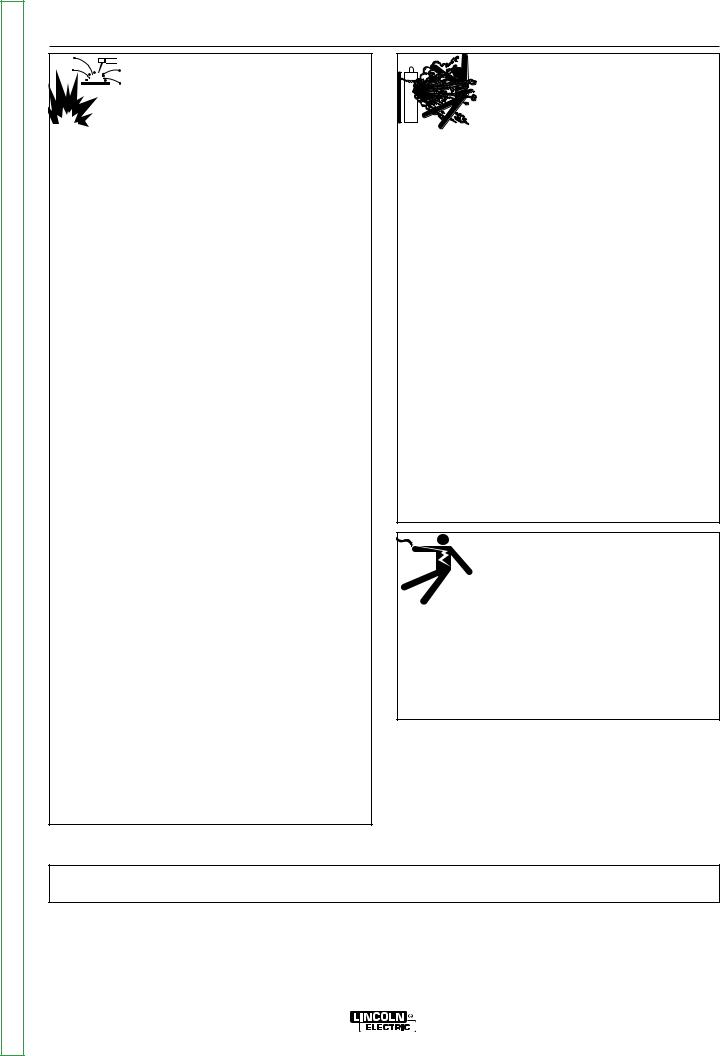
Return to Master TOC
Return to Master TOC
Return to Master TOC
Return to Master TOC
iii |
|
|
|
|
SAFETY |
|
|
|
iii |
|
|
|
|
|
|
|
|
|
|
||
|
WELDING |
and |
CUTTING |
CYLINDER may explode |
||||||
|
SPARKS can cause fire or |
if damaged. |
|
|
|
|||||
|
explosion. |
|
|
7.a. Use only |
compressed |
gas |
cylinders |
|||
|
|
|
|
|
|
|||||
|
6.a. Remove fire hazards from the welding area.If |
containing the correct shielding gas for the |
||||||||
|
process used and |
properly |
operating |
|||||||
|
this is not possible, cover them to prevent the welding sparks |
|||||||||
|
regulators |
designed |
for |
the |
gas and |
|||||
|
from starting a fire. Remember that welding sparks and hot |
|||||||||
|
pressure used. All hoses, fittings, etc. should be suitable for |
|||||||||
|
materials from welding can easily go through small cracks |
|||||||||
|
the application and maintained in good condition. |
|
||||||||
|
and openings to adjcent areas. Avoid welding near hydraulic |
|
||||||||
|
|
|
|
|
|
|||||
|
lines. Have a fire extinguisher readily available. |
7.b. Always keep cylinders in an upright position securely |
||||||||
|
|
|
|
|
|
|||||
6.b. Where compressed gases are to be used at the job site, |
chained to an undercarriage or fixed support. |
|
||||||||
|
|
|
|
|
||||||
|
special precautions should be used to prevent hazardous |
7.c. Cylinders should be located: |
|
|
|
|
||||
|
situations. Refer to “Safety in Welding and Cutting” (ANSI |
|
|
|
|
|||||
|
• Away from areas where they may be struck or subjected to |
|||||||||
|
Standard Z49.1) |
and the |
operating |
information for the |
||||||
|
physical damage. |
|
|
|
|
|||||
|
equipment being used. |
|
|
|
|
|
|
|
||
|
|
|
|
|
|
|
|
|
||
6.c. When not welding, make certain no part of the electrode |
• A safe distance from arc welding or cutting operations and |
|||||||||
any other source of heat, sparks, or flame. |
|
|
||||||||
|
circuit is touching the work or ground. Accidental contact can |
|
|
|||||||
|
|
|
|
|
|
|||||
|
cause overheating and create a fire hazard. |
7.d. Never allow the electrode, electrode holder or any other |
||||||||
|
|
|
|
|
|
|||||
6.d. Do not heat, cut or weld tanks, drums or containers until the |
electrically “hot” parts to touch a cylinder. |
|
|
|||||||
|
|
|
|
|
||||||
|
proper steps have been taken to insure that such procedures |
7.e. Keep your head and face away from the cylinder valve outlet |
||||||||
|
will not cause flammable or toxic vapors from substances |
|||||||||
|
when opening the cylinder valve. |
|
|
|
||||||
|
inside. They can cause an explosion even though they have |
|
|
|
||||||
|
|
|
|
|
|
|||||
|
been “cleaned”. For information, purchase “Recommended |
7.f. Valve protection caps should always be in place and hand |
||||||||
|
Safe Practices for the Preparation for Welding and Cutting of |
|||||||||
|
tight except when the cylinder is in use or connected for |
|||||||||
|
Containers and |
Piping |
That |
Have |
Held Hazardous |
|||||
|
use. |
|
|
|
|
|||||
|
Substances”, AWS F4.1 from the American Welding Society |
|
|
|
|
|||||
|
|
|
|
|
|
|||||
|
(see address above). |
|
|
|
7.g. Read and follow the instructions on compressed gas |
|||||
6.e. Vent hollow castings or containers before heating, cutting or |
cylinders, associated equipment, and CGA publication P-l, |
|||||||||
“Precautions for Safe Handling of Compressed Gases in |
||||||||||
|
welding. They may explode. |
|
|
|
Cylinders,” available from the Compressed Gas Association |
|||||
6.f. |
Sparks and spatter are thrown from the welding arc. Wear oil |
1235 Jefferson Davis Highway, Arlington, VA 22202. |
||||||||
|
|
|
|
|
||||||
|
free protective garments such as leather gloves, heavy shirt, |
FOR ELECTRICALLY |
||||||||
|
cuffless trousers, high shoes and a cap over your hair. Wear |
|||||||||
|
ear plugs when welding out of position or in confined places. |
|||||||||
|
powered equipment. |
|||||||||
|
Always wear safety glasses with side shields when in a |
|||||||||
|
welding area. |
|
|
|
|
|
|
|
|
|
6.g. Connect the work cable to the work as close to the welding |
8.a. Turn off input power using the disconnect |
|||||||||
switch at the fuse box before working on |
||||||||||
|
area as practical. Work cables connected to the building |
the equipment. |
|
|
|
|||||
|
framework or other locations away from the welding area |
8.b. Install equipment in accordance with the U.S. National |
||||||||
|
increase the possibility of the welding current passing through |
|||||||||
|
lifting chains, crane cables or other alternate circuits. This can |
Electrical Code, all local codes and the manufacturer’s |
||||||||
|
create fire hazards or overheat lifting chains or cables until |
recommendations. |
|
|
|
|
||||
|
they fail. |
|
|
|
|
8.c. Ground the equipment in accordance with the U.S. National |
||||
|
|
|
|
|
|
|||||
6.h. Also see item 1.c. |
|
|
|
|
Electrical Code and the manufacturer’s recommendations. |
|||||
6.I. Read and follow NFPA 51B “ Standard for Fire Prevention During Welding, Cutting and Other Hot Work”, available from NFPA, 1 Batterymarch Park,PO box 9101, Quincy, Ma 022690-9101.
6.j. Do not use a welding power source for pipe thawing.
Refer to http://www.lincolnelectric.com/safety for additional safety information.
VANTAGE® 400

Return to Master TOC
Return to Master TOC
Return to Master TOC
Return to Master TOC
iv |
SAFETY |
iv |
|
PRÉCAUTIONS DE SÛRETÉ
Pour votre propre protection lire et observer toutes les instructions et les précautions de sûreté specifiques qui parraissent dans ce manuel aussi bien que les précautions de sûreté générales suivantes:
Sûreté Pour Soudage A L’Arc
1.Protegez-vous contre la secousse électrique:
a.Les circuits à l’électrode et à la piéce sont sous tension quand la machine à souder est en marche. Eviter toujours tout contact entre les parties sous tension et la peau nue ou les vétements mouillés. Porter des gants secs et sans trous pour isoler les mains.
b.Faire trés attention de bien s’isoler de la masse quand on soude dans des endroits humides, ou sur un plancher metallique ou des grilles metalliques, principalement dans
les positions assis ou couché pour lesquelles une grande partie du corps peut être en contact avec la masse.
c.Maintenir le porte-électrode, la pince de masse, le câble de soudage et la machine à souder en bon et sûr état defonctionnement.
d.Ne jamais plonger le porte-électrode dans l’eau pour le refroidir.
e.Ne jamais toucher simultanément les parties sous tension des porte-électrodes connectés à deux machines à souder parce que la tension entre les deux pinces peut être le total de la tension à vide des deux machines.
f.Si on utilise la machine à souder comme une source de courant pour soudage semi-automatique, ces precautions pour le porte-électrode s’applicuent aussi au pistolet de soudage.
2.Dans le cas de travail au dessus du niveau du sol, se protéger contre les chutes dans le cas ou on recoit un choc. Ne jamais enrouler le câble-électrode autour de n’importe quelle partie du corps.
3.Un coup d’arc peut être plus sévère qu’un coup de soliel, donc:
a.Utiliser un bon masque avec un verre filtrant approprié ainsi qu’un verre blanc afin de se protéger les yeux du rayonnement de l’arc et des projections quand on soude ou quand on regarde l’arc.
b.Porter des vêtements convenables afin de protéger la peau de soudeur et des aides contre le rayonnement de l‘arc.
c.Protéger l’autre personnel travaillant à proximité au soudage à l’aide d’écrans appropriés et non-inflammables.
4.Des gouttes de laitier en fusion sont émises de l’arc de soudage. Se protéger avec des vêtements de protection libres de l’huile, tels que les gants en cuir, chemise épaisse, pantalons sans revers, et chaussures montantes.
5.Toujours porter des lunettes de sécurité dans la zone de soudage. Utiliser des lunettes avec écrans lateraux dans les zones où l’on pique le laitier.
6.Eloigner les matériaux inflammables ou les recouvrir afin de prévenir tout risque d’incendie dû aux étincelles.
7.Quand on ne soude pas, poser la pince à une endroit isolé de la masse. Un court-circuit accidental peut provoquer un échauffement et un risque d’incendie.
8.S’assurer que la masse est connectée le plus prés possible de la zone de travail qu’il est pratique de le faire. Si on place la masse sur la charpente de la construction ou d’autres endroits éloignés de la zone de travail, on augmente le risque de voir passer le courant de soudage par les chaines de levage, câbles de grue, ou autres circuits. Cela peut provoquer des risques d’incendie ou d’echauffement des chaines et des câbles jusqu’à ce qu’ils se rompent.
9.Assurer une ventilation suffisante dans la zone de soudage. Ceci est particuliérement important pour le soudage de tôles galvanisées plombées, ou cadmiées ou tout autre métal qui produit des fumeés toxiques.
10.Ne pas souder en présence de vapeurs de chlore provenant d’opérations de dégraissage, nettoyage ou pistolage. La chaleur ou les rayons de l’arc peuvent réagir avec les vapeurs du solvant pour produire du phosgéne (gas fortement toxique) ou autres produits irritants.
11.Pour obtenir de plus amples renseignements sur la sûreté, voir le code “Code for safety in welding and cutting” CSA Standard W 117.2-1974.
PRÉCAUTIONS DE SÛRETÉ POUR LES MACHINES À SOUDER À TRANSFORMATEUR ET À REDRESSEUR
1.Relier à la terre le chassis du poste conformement au code de l’électricité et aux recommendations du fabricant. Le dispositif de montage ou la piece à souder doit être branché à une bonne mise à la terre.
2.Autant que possible, I’installation et l’entretien du poste seront effectués par un électricien qualifié.
3.Avant de faires des travaux à l’interieur de poste, la debrancher à l’interrupteur à la boite de fusibles.
4.Garder tous les couvercles et dispositifs de sûreté à leur place.
VANTAGE® 400

I- MASTER TABLE OF CONTENTS FOR ALL SECTIONS -
I
RETURN TO MAIN MENU
Page
Safety . . . . . . . . . . . . . . . . . . . . . . . . . . . . . . . . . . . . . . . . . . . . . . . . . . . . . . . . . . . . . . . . . . . . . . . . . . .i-iv
Installation . . . . . . . . . . . . . . . . . . . . . . . . . . . . . . . . . . . . . . . . . . . . . . . . . . . . . . . . . . . . . . . . . .Section A
Operation . . . . . . . . . . . . . . . . . . . . . . . . . . . . . . . . . . . . . . . . . . . . . . . . . . . . . . . . . . . . . . . . . .Section B
Accessories . . . . . . . . . . . . . . . . . . . . . . . . . . . . . . . . . . . . . . . . . . . . . . . . . . . . . . . . . . . . . . . .Section C
Maintenance . . . . . . . . . . . . . . . . . . . . . . . . . . . . . . . . . . . . . . . . . . . . . . . . . . . . . . . . . . . . . . . .Section D
Theory of Operation . . . . . . . . . . . . . . . . . . . . . . . . . . . . . . . . . . . . . . . . . . . . . . . . . . . . . . . . . .Section E
Troubleshooting and Repair . . . . . . . . . . . . . . . . . . . . . . . . . . . . . . . . . . . . . . . . . . . . . . . . . . .Section F
Electrical Diagrams . . . . . . . . . . . . . . . . . . . . . . . . . . . . . . . . . . . . . . . . . . . . . . . . . . . . . . . . . .Section G
Parts Manual . . . . . . . . . . . . . . . . . . . . . . . . . . . . . . . . . . . . . . . . . . . . . . . . . . . . . . . . . . . . . . . . . . .P-528
VANTAGE® 400

Return to Master TOC
Return to Master TOC
Return to Master TOC
Return to Master TOC
A-1 |
TABLE OF CONTENTS - INSTALLATION SECTION |
A-1 |
|
||
|
|
|
Installation . . . . . . . . . . . . . . . . . . . . . . . . . . . . . . . . . . . . . . . . . . . . . . . . . . . . . . . . . . . . . . . . . . . . . . . . . . . . .A-1
Technical Specifications . . . . . . . . . . . . . . . . . . . . . . . . . . . . . . . . . . . . . . . . . . . . . . . . . . . . . . . . . . . . . . . .A-2
Safety Precautions . . . . . . . . . . . . . . . . . . . . . . . . . . . . . . . . . . . . . . . . . . . . . . . . . . . . . . . . . . . . . . . . .A-3
VRD (Voltage Reduction Device) . . . . . . . . . . . . . . . . . . . . . . . . . . . . . . . . . . . . . . . . . . . . . . . . . . . . .A-3
Location and Ventilation . . . . . . . . . . . . . . . . . . . . . . . . . . . . . . . . . . . . . . . . . . . . . . . . . . . . . . . . . . . . .A-3
Stacking . . . . . . . . . . . . . . . . . . . . . . . . . . . . . . . . . . . . . . . . . . . . . . . . . . . . . . . . . . . . . . . . . . . . . . . . .A-3
Angle of Operation . . . . . . . . . . . . . . . . . . . . . . . . . . . . . . . . . . . . . . . . . . . . . . . . . . . . . . . . . . . . . . . . .A-3
Lifting . . . . . . . . . . . . . . . . . . . . . . . . . . . . . . . . . . . . . . . . . . . . . . . . . . . . . . . . . . . . . . . . . . . . . . . . . . .A-3
High Altitude Operation . . . . . . . . . . . . . . . . . . . . . . . . . . . . . . . . . . . . . . . . . . . . . . . . . . . . . . . . . . . . .A-4
High Temperature Operation . . . . . . . . . . . . . . . . . . . . . . . . . . . . . . . . . . . . . . . . . . . . . . . . . . . . . . . . .A-4
Cold Weather Operation . . . . . . . . . . . . . . . . . . . . . . . . . . . . . . . . . . . . . . . . . . . . . . . . . . . . . . . . . . . .A-4
Towing . . . . . . . . . . . . . . . . . . . . . . . . . . . . . . . . . . . . . . . . . . . . . . . . . . . . . . . . . . . . . . . . . . . . . . . . . .A-4
Vehicle Mounting . . . . . . . . . . . . . . . . . . . . . . . . . . . . . . . . . . . . . . . . . . . . . . . . . . . . . . . . . . . . . . . . . .A-4
Pre-Operation Engine Service . . . . . . . . . . . . . . . . . . . . . . . . . . . . . . . . . . . . . . . . . . . . . . . . . . . . . . . . . . .A-4
Oil . . . . . . . . . . . . . . . . . . . . . . . . . . . . . . . . . . . . . . . . . . . . . . . . . . . . . . . . . . . . . . . . . . . . . . . . . . . . . .A-5
Fuel . . . . . . . . . . . . . . . . . . . . . . . . . . . . . . . . . . . . . . . . . . . . . . . . . . . . . . . . . . . . . . . . . . . . . . . . . . . .A-5
Engine Coolant . . . . . . . . . . . . . . . . . . . . . . . . . . . . . . . . . . . . . . . . . . . . . . . . . . . . . . . . . . . . . . . . . . .A-5
Battery Connections . . . . . . . . . . . . . . . . . . . . . . . . . . . . . . . . . . . . . . . . . . . . . . . . . . . . . . . . . . . . . . .A-5
Muffler Outlet Pipe . . . . . . . . . . . . . . . . . . . . . . . . . . . . . . . . . . . . . . . . . . . . . . . . . . . . . . . . . . . . . . . . .A-5
Spark Arrester . . . . . . . . . . . . . . . . . . . . . . . . . . . . . . . . . . . . . . . . . . . . . . . . . . . . . . . . . . . . . . . . . . . .A-5
Remote Control . . . . . . . . . . . . . . . . . . . . . . . . . . . . . . . . . . . . . . . . . . . . . . . . . . . . . . . . . . . . . . . . . . .A-5
Electrical Connections . . . . . . . . . . . . . . . . . . . . . . . . . . . . . . . . . . . . . . . . . . . . . . . . . . . . . . . . . . . . . . . . .A-6
Machine Grounding . . . . . . . . . . . . . . . . . . . . . . . . . . . . . . . . . . . . . . . . . . . . . . . . . . . . . . . . . . . . . . . .A-6
Welding Terminals . . . . . . . . . . . . . . . . . . . . . . . . . . . . . . . . . . . . . . . . . . . . . . . . . . . . . . . . . . . . . . . . .A-6
Welding Output Cables . . . . . . . . . . . . . . . . . . . . . . . . . . . . . . . . . . . . . . . . . . . . . . . . . . . . . . . . . . . . .A-6
Cable Installation . . . . . . . . . . . . . . . . . . . . . . . . . . . . . . . . . . . . . . . . . . . . . . . . . . . . . . . . . . . . . . . . . .A-6
Auxiliary Power Receptacles and Plugs . . . . . . . . . . . . . . . . . . . . . . . . . . . . . . . . . . . . . . . . . . . . . . . . . . . . . . .A-7
Standby Power Connections . . . . . . . . . . . . . . . . . . . . . . . . . . . . . . . . . . . . . . . . . . . . . . . . . . . . . . . . . . . . . . .A-7
Premises Wiring . . . . . . . . . . . . . . . . . . . . . . . . . . . . . . . . . . . . . . . . . . . . . . . . . . . . . . . . . . . . . . . . . . . . . . . . .A-8
Connection of Lincoln Electric Wire Feeders . . . . . . . . . . . . . . . . . . . . . . . . . . . . . . . . . . . . . . . . . . . . . .A-9, A-10
VANTAGE® 400
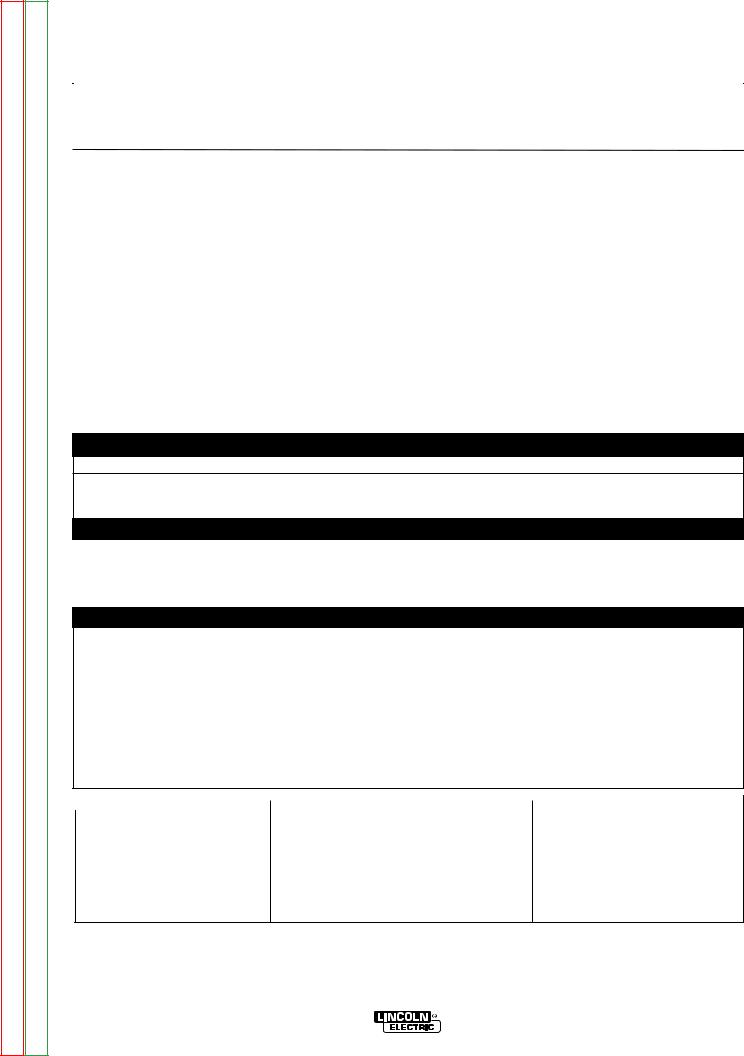
Return to Section TOC |
Return to Master TOC |
Return to Section TOC |
Return to Master TOC |
Return to Section TOC |
Return to Master TOC |
Return to Section TOC |
Return to Master TOC |
A-2 |
|
|
|
INSTALLATION |
|
|
|
A-2 |
||
|
|
|
|
|
|
|
|
|
||
|
|
|
|
|
|
|
|
|
||
TECHNICAL SPECIFICATIONS - VANTAGE® 400 (K2410-1) (K2410-2) |
|
|||||||||
|
|
|
|
|
|
|
|
|
|
|
|
|
|
|
INPUT - DIESEL ENGINE |
|
|
|
|
||
|
|
|
|
|
|
|
|
|||
Make/Model |
Description |
|
Speed (RPM) |
|
Displacement |
Starting |
|
Capacities |
||
PERKINS |
|
|
|
|
cu. in. (ltrs.) |
System |
|
|
||
(K2410-1) |
4 cylinder |
|
High Idle 1880 |
135.6(2.2) |
12VDC Battery |
& |
Fuel: 15 gal. |
|||
404C-22 |
32.7 HP |
|
|
|
starter |
|
(57 L) |
|||
|
1800 RPM |
|
|
Bore x Stroke inch (mm) |
(Group 34; 650 |
|
Oil: 8.45Qts. (8L) |
|||
|
naturally aspirated |
Full Load 1800 |
|
3.43 X 3.64 |
cold crank amps) |
Radiator Coolant: |
||||
|
|
|||||||||
(K2410-2) |
water cooled |
|
|
|
65 Amp Alternator |
|
||||
404D-22 |
Diesel Engine |
|
Low Idle 1400 |
|
(87.1 x 92.5mm) |
W / Built in Regulator |
8.0 Qts. (7.6L) |
|||
|
|
|
|
|
|
|
|
|
|
|
|
RATED OUTPUT @ 104° F (40° C) - WELDER |
|
|
|||||||
Welding Process |
|
Welding Output |
|
Output Range |
|
Max. Weld OCV |
||||
|
|
Current/Voltage/Duty Cycle |
|
|
@Rated Load RPM |
|||||
|
|
|
400A / 36V / 100% |
|
|
|
|
|
|
|
DC Constant Current |
|
450A / 32V / 100% |
|
30 TO 500 AMPS |
|
|
|
|||
|
|
|
|
|
|
|
|
|
|
|
DC Pipe Current |
|
300A / 32V / 100% |
|
40 TO 300 AMPS |
|
|
2 |
|||
|
|
|
|
|
|
|
|
|
|
60 Volts |
Touch-Start™TIG |
|
250A / 30V / 100% |
|
20 TO 250 AMPS |
|
|
||||
|
|
|
|
|
||||||
|
|
|
400A / 36V / 100% |
|
|
|
|
|
|
|
DC Constant Voltage |
|
450A / 32V / 100% |
|
14 TO 36 VOLTS |
|
|
|
|||
|
|
|
|
|
|
|
|
|
|
|
RATED OUTPUT @ 104° F (40° C).- GENERATOR
Auxiliary Power 1
12,000 Watts Peak, / 11,000 Watts Continuous, 60 Hz 120/240 Volts Single Phase 19,000 Watts Peak, / 17,000 Watts Continuous, 60 Hz, 240 Volts 3-Phase
PHYSICAL DIMENSIONS
HEIGHT |
WIDTH |
DEPTH |
|
WEIGHT |
|
35.94* in. |
25.30 in |
60.00 in. |
|
|
|
|
1230 lbs. (559kg.) |
|
|||
913 mm |
643 mm |
1524 mm |
|
|
|
|
|
|
|||
|
|
|
|||
|
|
|
|
|
|
ENGINE
LUBRICATION |
EMISSIONS |
FUEL SYSTEM |
|
GOVERNOR |
||||
Full Pressure |
(K2410-1) EPA |
Tier II |
Mechanical Fuel Pump, Auto air bleed system |
Mechanical |
||||
with Full Flow Filter |
(K2410-2) EPA |
Tier 4 Interim |
|
Electric shutoff solenoid, Indirect fuel injector. |
|
|||
|
|
|
|
|
|
|
|
|
AIR CLEANER |
ENGINE IDLER |
|
|
MUFFLER |
|
ENGINE PROTECTION |
||
|
|
|
|
|
Low noise Muffler: |
|
Shutdown on low oil |
|
Single Element |
Automatic Idler |
|
|
Top outlet can be rotated. |
|
pressure & high engine |
||
|
|
|
Made from long life, aluminized steel. |
|
coolant temperature |
|||
ENGINE WARRANTY: 2 years / 2000 hours, all non-electric components, 3 years major non-electric components . See Perkins warranty for details.
|
MACHINE SPECIFICATIONS |
|
RECEPTACLES |
AUXILIARY POWER CIRCUIT BREAKER |
OTHER CIRCUIT BREAKERS |
|
|
|
(2) 120VAC GFCI Duplex (5-20R) |
Two 20AMP for Two Duplex Receptacle |
10AMP for Battery Charging Circuit |
(1) 120/240VAC Dual Voltage |
(1) 50AMP for Dual Voltage and for |
10AMP for 42V Wire Feeder Power |
Full KVA (14-50R) |
3-Phase (3-pole) |
|
(1) 240VAC 3-Phase (15-50R)
1.Output rating in watts is equivalent to volt-amperes at unity power factor. Output voltage is within ± 10% at all loads up to rated capacity. When welding, available auxiliary power will be reduced.
* To Top of enclosure, add 10.68”(271.3mm) to top of exhaust pipe. Add 6.67”(169.4mm) to top of Lift Bail.
2.Reduced to less than 32V in the CC-stick Mode when VRD (VOLTAGE REDUCTION DEVICE) is on.
VANTAGE® 400
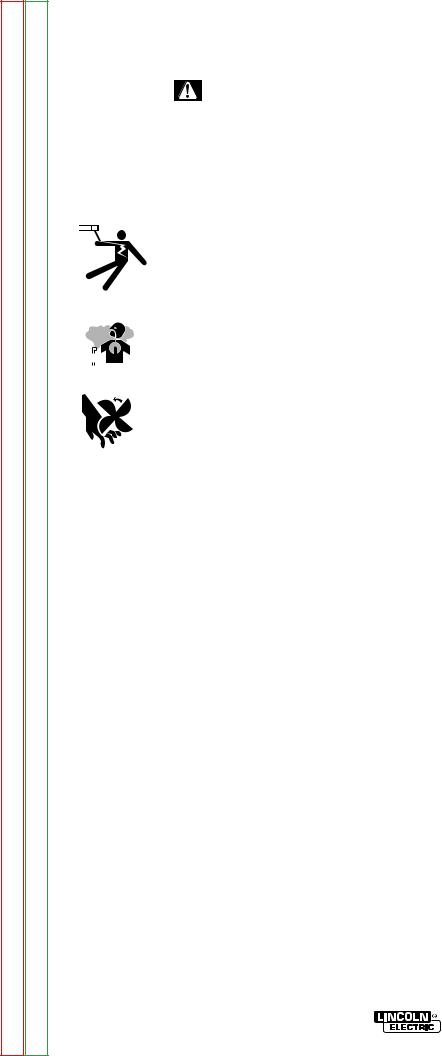
Return to Section TOC |
Return to Master TOC |
Return to Section TOC |
Return to Master TOC |
Return to Section TOC |
Return to Master TOC |
Return to Section TOC |
Return to Master TOC |
A-3 |
INSTALLATION |
A-3 |
||||||
|
|
|
||||||
|
|
|
|
|
|
|
||
SAFETY PRECAUTIONS |
LOCATION AND VENTILATION |
|
||||||
|
|
|
|
|
|
|
||
|
|
|
|
WARNING |
|
The welder should be located to provide an unrestrict- |
||
|
|
|
|
|
|
|||
Do not attempt to use this equipment until you |
ed flow of clean, cool air to the cooling air inlets and to |
|||||||
avoid restricting the cooling air outlets. Also, locate the |
||||||||
have thoroughly read the engine manufacturer’s |
||||||||
welder so that the engine exhaust fumes are properly |
||||||||
manual supplied with your welder. It includes |
||||||||
important safety precautions, detailed engine start- |
vented to an outside area. |
|
||||||
ing, operating and maintenance instructions, and |
|
|
||||||
parts lists. |
|
|
STACKING |
|
||||
------------------------------------------------------------------------ |
VANTAGE® 400 machines cannot be stacked. |
|
||||||
|
|
|
|
ELECTRIC SHOCK can kill. |
|
|
||
|
|
|
|
• Do not touch electrically live parts or |
ANGLE OF OPERATION |
|
||
|
|
|
|
electrode with skin or wet clothing. |
|
|||
|
|
|
|
Engines are designed to run in the level condition |
||||
|
|
|
|
• Insulate yourself from work and |
||||
|
|
|
|
which is where the optimum performance is achieved. |
||||
|
|
|
|
ground |
||||
|
|
|
|
The maximum angle of continuous operation is 25 |
||||
|
|
|
|
• Always wear dry insulating gloves. |
||||
------------------------------------------------------------------------ |
|
|
|
ENGINE EXHAUST can kill. |
degrees in all directions, 35 degrees Intermittent (less |
|||
|
|
|
|
than 10 minutes continuous) in all directions. If the |
||||
|
|
|
|
• Use in open, well ventilated areas or |
engine is to be operated at an angle, provisions must |
|||
|
|
|
|
vent exhaust outside. |
be made for checking and maintaining the oil level at |
|||
|
|
|
|
|||||
|
|
|
|
|
|
the normal (FULL) oil capacity in the crankcase. |
|
|
------------------------------------------------------------------------ |
|
|||||||
|
|
|||||||
|
|
|
|
MOVING PARTS can injure. |
When operating the welder at an angle, the effective |
|||
|
|
|
|
• Do not operate with doors open or |
||||
|
|
|
|
guards off. |
fuel capacity will be slightly less than the amount spec- |
|||
|
|
|
|
• Stop engine before servicing. |
ified. |
|
||
|
|
|
|
• Keep away from moving parts. |
|
|
||
------------------------------------------------------------------------ |
LIFTING |
|
See additional warning information at front |
||
The VANTAGE® 400 weighs approximately 1345lbs. |
||
of this operator’s manual. |
||
(611kg.) with a full tank of fuel 1230lbs.(559kg) less |
||
|
||
Only qualified personnel should install, |
fuel. A lift bail is mounted to the machine and should |
|
always be used when lifting the machine. |
||
use, or service this equipment. |
||
|
VRD (VOLTAGE REDUCTION DEVICE)
The VRD feature provides additional safety in the CC-Stick mode especially in an environment with a higher risk of electric shock such as wet areas and hot humid sweaty conditions.
The VRD reduces the OCV (Open Circuit Voltage) at the welding output terminals while not welding to less than 32V DC when the resistance of the output circuit is above 200Ω (ohms).
The VRD requires that the welding cable connections be kept in good electrical condition because poor connections will contribute to poor starting. Having good electrical connections also limits the possibility of other safety issues such as heat-generated damage, burns and fires.
The machine is shipped with the VRD switch in the “Off” position. To turn it “On” or “Off”:
•Turn the engine “Off”.
•Disconnect the negative battery cable.
•Lower the control panel.
•Place the VRD switch in the “On or “Off” position. With the VRD switch in the “On” position, the VRD lights are enabled.
VANTAGE® 400
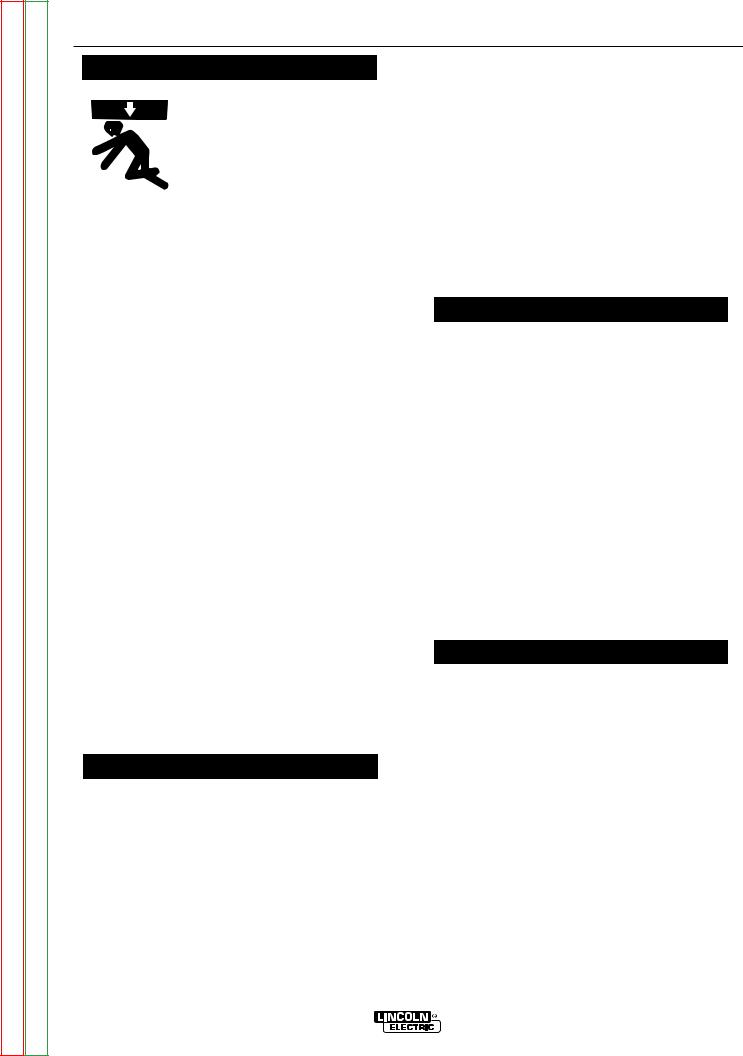
Return to Section TOC |
Return to Master TOC |
Return to Section TOC |
Return to Master TOC |
Return to Section TOC |
Return to Master TOC |
Return to Section TOC |
Return to Master TOC |
A-4 |
INSTALLATION |
A-4 |
|
 WARNING
WARNING
• Lift only with equipment of adequate lifting capacity.
• Be sure machine is stable when lifting.
•Do not lift this machine using lift bail if it is equipped with a heavy accessory such as trailer or gas cylinder.
FALLING |
• Do not lift machine if lift bail is |
1.Design capacity of trailer vs. weight of Lincoln equipment and likely additional attachments.
2.Proper support of, and attachment to, the base of the welding equipment so there will be no undue stress to the framework.
3.Proper placement of the equipment on the trailer to insure stability side to side and front to back when being moved and when standing by itself while being operated or serviced.
4.Typical conditions of use, i.e., travel speed; roughness of surface on which the trailer will be operated; environmental conditions; like maintenance.
5.Conformance with federal, state and local laws.(1)
(1)Consult applicable federal, state and local laws regarding specific requirements for use on public high-
EQUIPMENT can |
damaged. |
ways. |
|
|
|
cause injury. |
• Do not operate machine while |
|
suspended from lift bail.
--------------------------------------------------------------------------------
HIGH ALTITUDE OPERATION
At higher altitudes, output derating may be necessary. For maximum rating, derate the machine 2.5% to 3.5% for every 1000 ft. (305m). Due to new EPA and other local emissions regulations, modifications to the engine for high altitude are restricted within the United States. For use above 6000 ft.(1828 m) an authorized Perkins engine field service shop should be contacted to determine if any adjustments can be made for operation in higher elevations.
HIGH TEMPERATURE OPERATION
At temperatures above 104°F(40°C), Welder output derating is necessary. For maximum output ratings, derate the welder output 2 volts for every 18°F(10°C) above 104°F(40°C).
COLD WEATHER STARTING:
With a fully charged battery and the proper oil, the engine should start satisfactorily down to -15°F(-26C°). If the engine must be frequently started at or below 0°F (-18°C), it may be desirable to install cold-starting aides. The use of No. 1D diesel fuel is recommended in place of No. 2D at temperatures below 23°F (-5°C). Allow the engine to warm up before applying a load or switching to high idle.
Note: Extreme cold weather starting may require longer glow plug operation.
 WARNING
WARNING
Under no conditions should ether or other starting fluids be used with this engine!
------------------------------------------------------------------------
VEHICLE MOUNTING
 WARNING
WARNING
Improperly mounted concentrated loads may cause unstable vehicle handling and tires or other components to fail.
•Only transport this Equipment on serviceable vehicles which are rated and designed for such loads.
•Distribute, balance and secure loads so vehicle is stable under conditions of use.
•Do not exceed maximum rated loads for components such as suspension, axles and tires.
•Mount equipment base to metal bed or frame of vehicle.
•Follow vehicle manufacturer’s instructions.
------------------------------------------------------------------------
PRE-OPERATION ENGINE SERVICE
READ the engine operating and maintenance instructions supplied with this machine.
 WARNING
WARNING
•Stop engine and allow to cool before fueling
•Do not smoke when fueling.
•Fill fuel tank at a moderate rate and do not overfill.
•Wipe up spilled fuel and allow fumes to clear before starting engine.
•Keep sparks and flame away from tank.
------------------------------------------------------------------------
TOWING
Use a recommended trailer for use with this equipment for road, in-plant and yard towing by a vehicle(1). If the user adapts a nonLincoln trailer, he must assume responsibility that the method of attachment and usage does not result in a safety hazard or damage the welding equipment. Some of the factors to be considered are as follows:
VANTAGE® 400
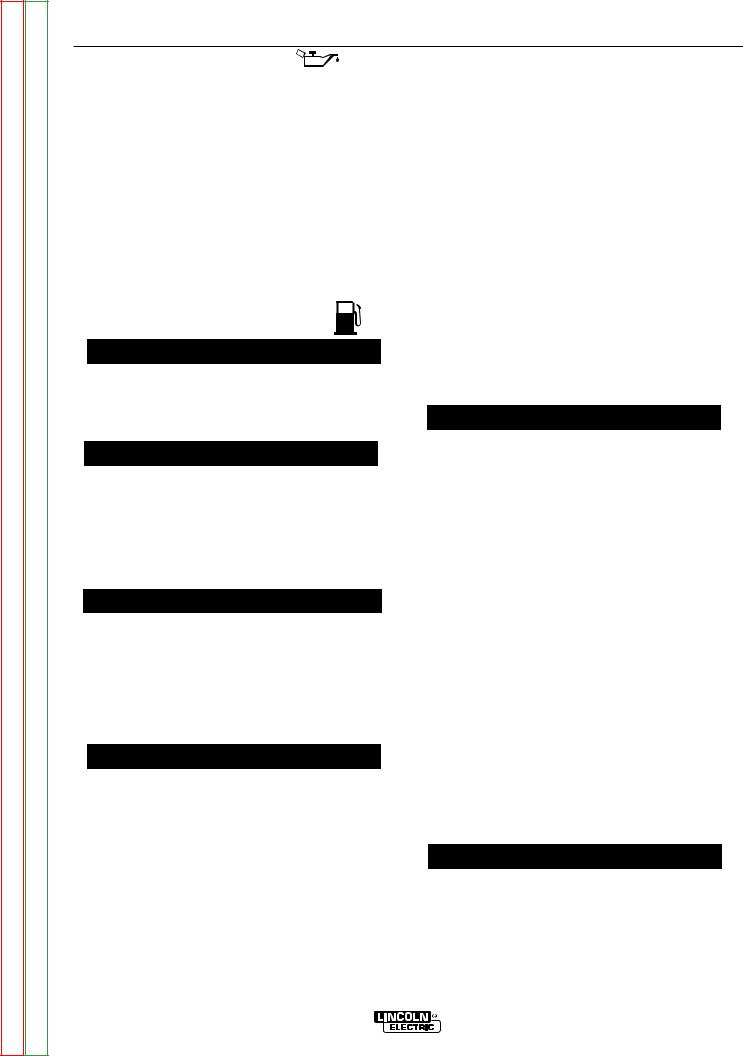
Return to Section TOC |
Return to Master TOC |
Return to Section TOC |
Return to Master TOC |
Return to Section TOC |
Return to Master TOC |
Return to Section TOC |
Return to Master TOC |
A-5 |
INSTALLATION |
A-5 |
|
OIL
The VANTAGE® 400 is shipped with the engine crankcase filled with high quality SAE 10W-30 Oil that meets classification CG-4 or CH-4 for diesel engines. Check the oil level before starting the engine. If it is not up to the full mark on the dip stick, add oil as required. Check the oil level every four hours of running time during the first 50 running hours. Refer to the engine Operator’s Manual for specific oil recommendations and break-in information. The oil change interval is dependent on the quality of the oil and the operating environment. Refer to the Engine Operator’s Manual for more details on the proper service and maintenance intervals.
FUEL
USE DIESEL FUEL ONLY
 WARNING
WARNING
•Fill the fuel tank with clean, fresh fuel. The capacity of the tank is 15 gals. (57 ltrs). When the fuel gauge reads empty the tank contains approximately 2 gals. (7.6ltrs.) of reserve fuel.
 WARNING
WARNING
NOTE: A fuel shut off valve is located on the prefilter/sediment filter. Which should be in the closed position when the welder is not used for extended periods of time.
------------------------------------------------------------------------
ENGINE COOLING SYSTEM
 WARNING
WARNING
Air to cool the engine is drawn in the side and exhausted through radiator & case back. It is important that the intake and exhaust air is not restricted. Allow a minimum clearance of 1ft. (0.6m) from the case back and 16in.(406mm) from either side of the base to a vertical surface.
------------------------------------------------------------------------
 CAUTION
CAUTION
BATTERY CONNECTION
Use caution as the electrolyte is a strong acid that can burn skin and damage eyes.
------------------------------------------------------------------------
NOTE: This machine is furnished with a wet charged battery; if unused for several months, the battery may require a booster charge. Be careful to charge the battery with the correct polarity. (See Battery in
Maintenance Section)
MUFFLER OUTLET PIPE
Using the clamp provided secure the outlet pipe to the outlet tube with the pipe positioned such that it will direct the exhaust in the desired direction. Tighten using a 9/16" socket or wrench.
SPARK ARRESTER
Some federal, state or local laws may require that gasoline or diesel engines be equipped with exhaust spark arresters when they are operated in certain locations where unarrested sparks may present a fire hazard. The standard muffler included with this welder does not qualify as a spark arrester. When required by local regulations, a suitable spark arrester, such as the K903-1 must be installed and properly maintained.
 WARNING
WARNING
An incorrect spark arrestor may lead to damage to the engine or adversely affect performance.
------------------------------------------------------------------------
REMOTE CONTROL
The VANTAGE® 400 is equipped with a 6-pin and a 14-pin connector. The 6-pin connector is for connecting the K857 or K857-1 Remote Control or for TIG welding, the K870 foot Amptrol or the K936-3 hand Amptrol. When in the CC-STICK, DOWNHILL PIPE, or CVWIRE modes and when a remote control is connected to the 6-pin Connector, the auto-sensing circuit automatically switches the OUTPUT control from control at the welder to remote control.
When in TOUCH START TIG mode and when a Amptrol is connected to the 6-Pin Connector, the OUTPUT dial is used to set the maximum current range of the CURRENT CONTROL of the Amptrol.
The 14-pin connector is used to directly connect a wire feeder control cable. In the CV-WIRE mode, when the control cable is connected to the 14-pin connector, the auto-sensing circuit automatically makes the Output Control inactive and the wire feeder voltage control active
The VANTAGE® 400 is shipped with the negative battery cable disconnected. Make certain that the RUNSTOP switch is in the STOP position. Remove the two screws from the battery tray using a screwdriver or a 3/8" socket. Attach the negative battery cable to the negative battery terminal and tighten using a 1/2" socket or wrench.
 WARNING
WARNING
NOTE: When a wire feeder with a built in welding voltage control is connected to the 14-pin connector, do not connect anything to the 6-pin connector.
----------------------------------------------------------------------
VANTAGE® 400
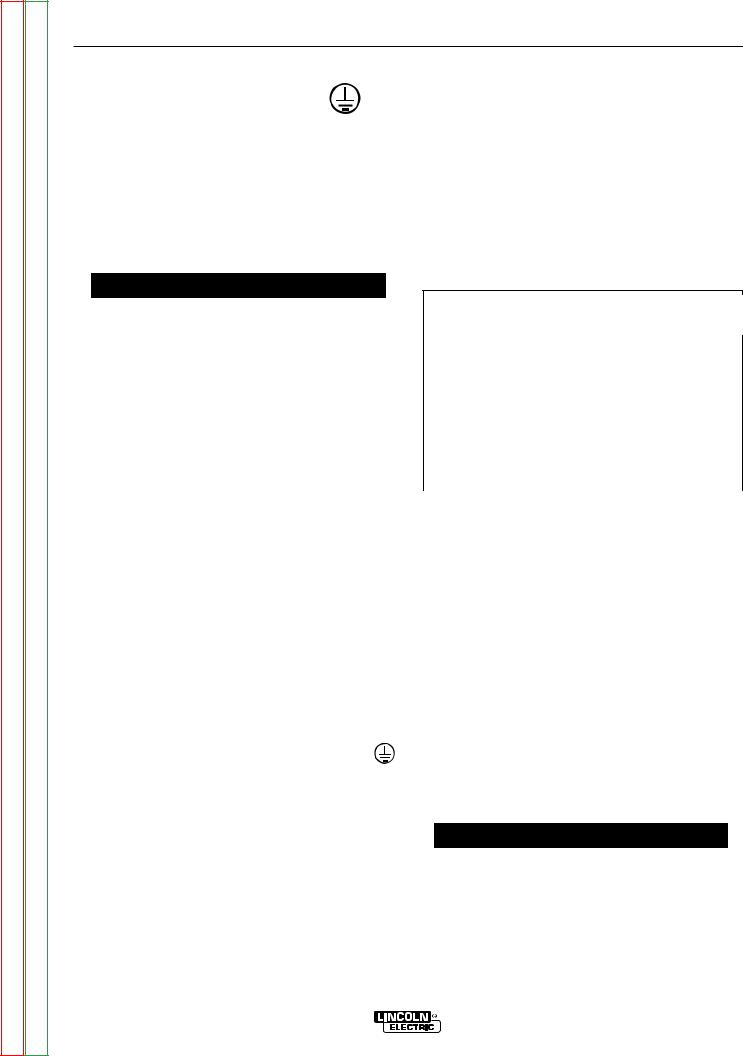
Return to Section TOC |
Return to Master TOC |
Return to Section TOC |
Return to Master TOC |
Return to Section TOC |
Return to Master TOC |
Return to Section TOC |
Return to Master TOC |
A-6 |
INSTALLATION |
A-6 |
|
ELECTRICAL CONNECTIONS
MACHINE GROUNDING
Because this portable engine driven welder creates its own power, it is not necessary to connect its frame to an earth ground, unless the machine is connected to premises wiring (home, shop, etc.)
To prevent dangerous electric shock, other equipment to which this engine driven welder supplies power must:
 WARNING
WARNING
•Be grounded to the frame of the welder using a grounded type plug or be double insulated.
•Do not ground the machine to a pipe that carries explosive or combustible material.
------------------------------------------------------------------------
When this welder is mounted on a truck or trailer, its frame must be electrically bonded to the metal frame of the vehicle. Use a #8 or larger copper wire connected between the machine grounding stud and the frame of the vehicle. When this engine driven welder is connected to premises wiring such as that in a home or shop, its frame must be connected to the system earth ground. See further connection instructions in the section entitled Standby Power Connections as well as the article on grounding in the latest National Electrical Code and the local code.
In general, if the machine is to be grounded, it should be connected with a #8 or larger copper wire to a solid earth ground such as a metal water pipe going into the ground for at least ten feet and having no insulated joints, or to the metal framework of a building which has been effectively grounded.
The National Electrical Code lists a number of alternate means of grounding electrical equipment. A machine grounding stud marked with the symbol
is provided on the front of the welder.
WELDING TERMINALS
The VANTAGE® 400 is equipped with a toggle switch for selecting "hot" welding terminal when in the "WELD TERMINALS ON" position or "cold" welding terminal when in the "REMOTELY CONTROLLED" position.
WELDING OUTPUT CABLES
With the engine off connect the electrode and work cables to the output studs. The welding process dictates the polarity of the electrode cable. These connections should be checked periodically and tightened with a 3/4" wrench.
Table A.1 lists recommended cable sizes and lengths for rated current and duty cycle. Length refers to the distance from the welder to the work and back to the welder. Cable diameters are increased for long cable lengths to reduce voltage drops.
TABLE A.1
TOTAL COMBINED LENGTH OF ELECTRODE AND WORK CABLES
|
|
|
|
|
|
|
|
|
|
Cable Length |
|
|
Cable Size for |
|
|
|
|
|
|
400 Amps |
|
||
|
|
|
|
|
60% |
Duty Cycle |
|
|
|
0-100 Ft. (0-30 meters) |
|
|
2 |
/ 0 AWG |
|
|
|
100-150 Ft. (30-46 meters) |
|
|
2 |
/ 0 AWG |
|
|
|
|
|
|
|
|
|
|
|
150-200 Ft. (46-61 meters) |
|
|
3 |
/ 0 AWG |
|
|
|
|
|
|
|
|
|
|
|
|
|
|
|
|
|
CABLE INSTALLATION
Install the welding cables to your VANTAGE® 400 as follows.
1.The engine must be OFF to install welding cables.
2.Remove the flanged nuts from the output terminals
.
3.Connect the electrode holder and work cables to the weld output terminals. The terminals are identified on the case front.
4.Tighten the flanged nuts securely.
5.Be certain that the metal piece you are welding (the “work”) is properly connected to the work clamp and cable.
6.Check and tighten the connections periodically.
 CAUTION
CAUTION
•Loose connections will cause the output terminals to overheat. The terminals may eventually melt.
•Do not cross the welding cables at the output terminal connection. Keep the cables isolated and separate from one another.
------------------------------------------------------------------------
VANTAGE® 400

Return to Section TOC |
Return to Master TOC |
Return to Section TOC |
Return to Master TOC |
Return to Section TOC |
Return to Master TOC |
Return to Section TOC |
Return to Master TOC |
A-7 |
INSTALLATION |
A-7 |
|
AUXILIARY POWER RECEPTACLES
Start the engine and set the “IDLER” control switch to the “High Idle” mode. Voltage is now correct at the receptacles for auxiliary power. This must be done before a tripped GFCI receptacle can be reset properly. See the MAINTENANCE section for more detailed information on testing and resetting the GFCI receptacle.
The auxiliary power of the VANTAGE® 400 consists of two 20 Amp-120 VAC (5-20R) duplex receptacles with GFCI protection, one 50 Amp 120/240 VAC (14-50R) receptacle and one 50 Amp 240VAC Three-Phase (1550R) receptacle.
The auxiliary power capacity is 12,000 watts Peak, 11,000 Watts Continuous of 60 Hz, single phase power. The auxiliary power capacity rating in watts is equivalent to volt-amperes at unity power factor. The max permissible current of the 240 VAC output is 50amps.
The 240 VAC output can be split to provide two separate 120 VAC outputs with a max permissible current of 50 Amps per output to two separate 120 VAC branch circuits (these circuits cannot be paralleled). Output voltage is within ± 10% at all loads up to rated capacity.
The Three-Phases auxiliary power capacity is 17,000 watts peak, 19,000 watts continuous. The maximum current is 45 amps.
120 V GFCI DUPLEX RECEPTACLES
A GFCI (Ground Fault Circuit Interrupter) electrical receptacle is a device to protect against electric shock should a piece of defective equipment connected to it develop a ground fault. If this situation should occur, the GFCI will trip, removing voltage from the output of the receptacle. If a GFCI receptacle is tripped see the MAINTENANCE section for detailed information on testing and resetting it. A GFCI receptacle should be properly tested at least once every month.
The 120 V auxiliary power receptacles should only be used with three wire grounded type plugs or approved double insulated tools with two wire plugs. The current rating of any plug used with the system must be at least equal to the current capacity of the associated receptacle.
NOTE: The 240 V receptacle has two 120 V circuits, but are of opposite polarities and cannot be paralleled.
All auxiliary power is protected by circuit breakers. The 120V has 20 Amp circuit breakers for each duplex receptacle. The 120/240V Single Phase and the 240V Three-Phase have a 50 Amp 3-pole Circuit Breaker that disconnects both hot leads and all three phases simultaneously.
STANDBY POWER CONNECTIONS
The VANTAGE® 400 is suitable for temporary, standby or emergency power using the engine manufacturer’s recommended maintenance schedule.
The VANTAGE® 400 can be permanently installed as a standby power unit for 240 VAC, 3 wire, single phase, 50 amp service. Connections must be made by a licensed electrician who can determine how the 120/240 VAC power can be adapted to the particular installation and comply with all applicable electrical codes.
•Install the double-pole, double-throw switch between the power company meter and the premises disconnect. Switch rating must be the same or greater than the customer’s premises disconnect and service over current protection.
•Take necessary steps to assure load is limited to the capacity of the generator by installing a 50 amp, 240 VAC double pole circuit breaker. Maximum rated load for each leg of the 240 VAC auxiliary is 50 amperes. Loading above the rated output will reduce output voltage below the allowable - 10% of rated voltage which may damage appliances or other motor-driven equipment and may result in overheating of the engine and/or alternator windings.
•Install a 50 amp, 120/240 VAC plug (NEMA Type 14-50P) to the double-pole circuit breaker using No. 6, 4 conductor cable of the desired length. (The 50 amp, 120/240 VAC plug is available in the optional K802R plug kit or as part number T12153-9.)
•Plug this cable into the 50 Amp, 120/240 Volt receptacle on the case front.
VANTAGE® 400
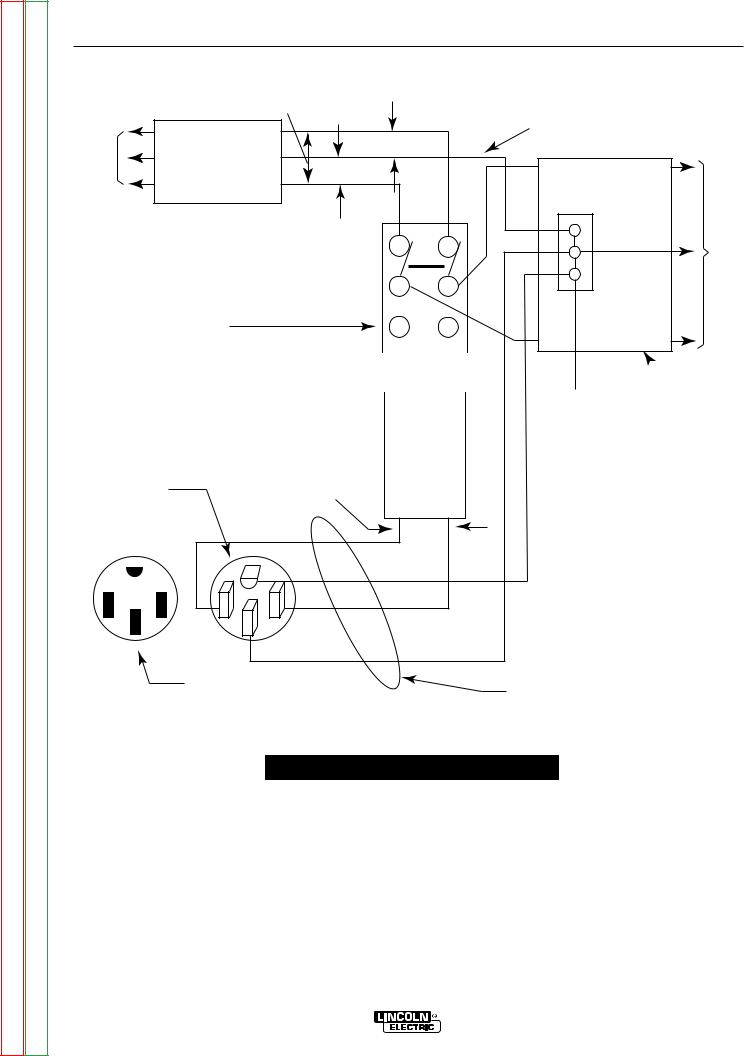
Return to Section TOC |
Return to Master TOC |
Return to Section TOC |
Return to Master TOC |
Return to Section TOC |
Return to Master TOC |
Return to Section TOC |
Return to Master TOC |
A-8 |
INSTALLATION |
A-8 |
|
CONNECTION OF VANTAGE® 400 TO PREMISES
|
240 VOLT |
|
|
GROUNDED CONDUCTOR |
|
240 Volt |
POWER |
|
120 VOLT |
||
|
||
60 Hz. |
|
|
3-Wire |
COMPANY |
|
|
||
Service |
120 VOLT |
|
|
||
|
METER |
|
|
NEUTRAL |
|
|
BUS |
N
LOAD
DOUBLE POLE DOUBLE THROW
SWITCH RATING TO BE THE SAME
AS OR GREATER THAN PREMISES
SERVICE OVERCURRENT
PROTECTION.
|
|
|
|
|
|
|
|
|
|
|
|
PREMISES |
|
|
|
|
|
|
|
|
|
|
|
|
|
|
|
|
|
|
|
|
|
|
|
|
|
DISCONNECT AND |
|
|
|
|
|
|
|
|
|
|
|
|
|
|
|
|
|
|
|
|
|
|
|
|
|
SERVICE |
|
|
|
|
|
GROUND |
|||||||
|
|
|
|
|
OVERCURRENT |
|||||||
|
|
50AMP |
|
|
|
|
|
|
|
|
||
|
|
|
|
|
|
|
|
|
|
|
||
|
|
240 VOLT |
|
|
|
|
|
|
|
|
PROTECTION |
|
|
|
|
|
|
|
|
|
|
|
|
||
|
|
DOUBLE |
|
|
POLE |
50 AMP, 120/240 |
|
CIRCUIT |
|
|
|
VOLT PLUG |
240 VOLT |
BREAKER |
|
|
|
NEMA TYPE 14-50 |
|
|
GND
N
50 AMP, 120/240 VOLT
RECEPTACLE NOTE: No. 6 COPPER CONDUCTOR CABLE SEE NATIONAL ELECTRICAL CODE FOR ALTERNATE WIRE
SIZE RECOMMENDATIONS.
 WARNING
WARNING
•Only a licensed, certified, trained electrician should install the machine to a premises or residential electrical system. Be certain that:
•The installation complies with the National Electrical Code and all other applicable electrical codes.
•The premises is isolated and no feedback into the utility system can occur. Certain state and local laws require the premises to be isolated before the generator is linked to the premises. Check your state and local requirements.
•A double pole, double throw transfer switch in conjunction with the properly rated double throw circuit breaker is connected between the generator power and the utility meter.
VANTAGE® 400

Return to Section TOC |
Return to Master TOC |
Return to Section TOC |
Return to Master TOC |
Return to Section TOC |
Return to Master TOC |
Return to Section TOC |
Return to Master TOC |
A-9 |
INSTALLATION |
A-9 |
|
|
|
||
|
|
|
|
CONNECTION OF LINCOLN ELEC- |
4. Control Cable Model: |
|
|
TRIC WIRE FEEDERS |
|
• Connect Control Cable between Engine Welder |
|
|
|
and Feeder. |
|
CONNECTION OF LN-7 OR LN-8 TO THE VANTAGE® 400
1.Shut the welder off.
2.Connect the LN-7 or LN-8 per instructions on the appropriate connection diagram in Section F.
3.Set the "WIRE FEEDER VOLTMETER" switch to either "+" or "-" as required by the electrode being used.
4.Set the "MODE" switch to the "CV WIRE " position.
5.Set the "ARC CONTROL" knob to "0" initially and adjust to suit.
6.Set the "WELD TERMINALS" switch to the "REMOTELY CONTROLLED" position.
7.Set the "IDLE" switch to the "HIGH" position.
CONNECTION OF LN-15 TO THE VANTAGE® 400
1.Shut the welder off.
2.For electrode Positive, connect the electrode cable to the "+" terminal of the welder and work cable to the "-" terminal of the welder. For electrode Negative, connect the electrode cable to the "-" terminal of the welder and work cable to the "+" terminal of the welder.
•Set the "WELD TERMINALS" switch to "REMOTELY CONTROLLED"
•Set the MODE switch to the "CV-WIRE " position.
•Set the "WIRE FEEDER VOLTMETER" switch to either "+" or "-" as required by the electrode polarity being used.
•Set the "ARC CONTROL" knob to "0" initially and adjust to suit.
•Set the "IDLE" switch to the "AUTO" position.
•When the gun trigger is closed, the current sensing circuit will cause the VANTAGE® 400 engine to go to the high idle speed, the wire will begin to feed and the welding process started. When welding is stopped, the engine will revert to low idle speed after approximately 12 seconds unless welding is resumed.
3.Across The-Arc Model:
•Attach the single lead from the front of the LN-15 to work using the spring clip at the end of the lead. This is a control lead to supply current to the wire feeder motor; it does not carry welding current.
•Set the "WELD TERMINALS" switch to "WELD TERMINALS ON".
•When the gun trigger is closed, the current sensing circuit will cause the VANTAGE® 400 engine to go to the high idle speed, the wire will begin to feed and the welding process started. When welding is stopped, the engine will revert to low idle speed after approximately 12 seconds unless welding is resumed.
VANTAGE® 400

Return to Section TOC |
Return to Master TOC |
Return to Section TOC |
Return to Master TOC |
Return to Section TOC |
Return to Master TOC |
Return to Section TOC |
Return to Master TOC |
A-10 |
INSTALLATION |
A-10 |
|
||
|
|
|
 WARNING
WARNING
Connection of the LN-25 to the VANTAGE® 400 Shut off welder before making any electrical connections.
------------------------------------------------------------------------
The LN-25 with or without an internal contactor may be used with the VANTAGE® 400. See the appropriate connection diagram in Section F.
NOTE: The LN-25 (K431) Remote Control Module and (K432) Remote Cable are not recommended for use with the VANTAGE® 400.
1.Shut the welder off.
2.For electrode Positive, connect the electrode cable from the LN-25 to the "+" terminal of the welder and work cable to the "-" terminal of the welder. For electrode Negative, connect the electrode cable from the LN-25 to the "-" terminal of the welder and work cable to the "+" terminal of the welder.
3.Attach the single lead from the front of the LN-25 to work using the spring clip at the end of the lead. This is a control lead to supply current to the wire feeder motor; it does not carry welding current.
4.Set the MODE switch to the "CV-WIRE " position.
5.Set the "WELD TERMINALS" switch to "WELD TERMINALS ON"
6.Set the "ARC CONTROL" knob to "0" initially and adjust to suit.
7.Set the "IDLE" switch to the "AUTO" position. When not welding, the VANTAGE® 400 engine will be at the low idle speed. If you are using an LN-25 with an internal contactor, the electrode is not energized until the gun trigger is closed.
8.When the gun trigger is closed, the current sensing circuit will cause the VANTAGE® 400 engine to go to the high idle speed, the wire will begin to feed and the welding process started. When welding is stopped, the engine will revert to low idle speed after approximately 12 seconds unless welding is resumed.
 CAUTION
CAUTION
If you are using an LN-25 without an internal contactor, the electrode will be energized when the VANTAGE® 400 is started.
------------------------------------------------------------------------
CONNECTION OF SPOOL GUN (K487-25) AND COBRAMATIC TO VANTAGE® 400
•Shut the welder off.
•Connect per instructions on the appropriate connection diagram in Section C.
CONNECTION OF PRINCE XL SPOOL GUN TO THE VANTAGE® 400
Connection of the Prince XL Spool Gun requires the use of the K1849-1 Adapter Module.
•Shut the Welder off.
•For electrode Positive, connect the electrode cable to the "+" terminal of the welder and work cable to the "-" terminal of the welder. For electrode Negative, connect the electrode cable "-" terminal of the welder and work cable to the "+" terminal of the welder.
•Connect the Control Cable of the Spool Gun to the Adapter Module and connect the Control Cable of the Adapter Module to the Welder.
•Connect the Gas Hose.
•Set the MODE switch to the "CV-WIRE " position.
•Set the "WELD TERMINALS" switch to "WELD TERMINALS ON".
•Set the "ARC CONTROL" knob to "0" initially and adjust to suit.
•Set the “IDLE” switch to the “HIGH” position.
See Section C for additional Connection Diagrams.
VANTAGE® 400

Return to Master TOC
Return to Master TOC
Return to Master TOC
Return to Master TOC
B-1 |
TABLE OF CONTENTS - OPERATION SECTION |
B-1 |
|
||
|
|
|
Operation . . . . . . . . . . . . . . . . . . . . . . . . . . . . . . . . . . . . . . . . . . . . . . . . . . . . . . . . . . . . . . . . . . . . . . . . . . . . . .B-1
Safety Precautions . . . . . . . . . . . . . . . . . . . . . . . . . . . . . . . . . . . . . . . . . . . . . . . . . . . . . . . . . . . . . . . . . . .B-2 General Description . . . . . . . . . . . . . . . . . . . . . . . . . . . . . . . . . . . . . . . . . . . . . . . . . . . . . . . . . . . . . . . . . . .B-2 For Auxiliary Power . . . . . . . . . . . . . . . . . . . . . . . . . . . . . . . . . . . . . . . . . . . . . . . . . . . . . . . . . . . . . . . . . . .B-2 Engine Operation . . . . . . . . . . . . . . . . . . . . . . . . . . . . . . . . . . . . . . . . . . . . . . . . . . . . . . . . . . . . . . . . . . . . .B-2 Add Fuel . . . . . . . . . . . . . . . . . . . . . . . . . . . . . . . . . . . . . . . . . . . . . . . . . . . . . . . . . . . . . . . . . . . . . . . .B-2 Break in Period . . . . . . . . . . . . . . . . . . . . . . . . . . . . . . . . . . . . . . . . . . . . . . . . . . . . . . . . . . . . . . . . . . .B-2 Welder Controls . . . . . . . . . . . . . . . . . . . . . . . . . . . . . . . . . . . . . . . . . . . . . . . . . . . . . . . . . . . . . . . . . . .B-3,B-4 Engine Controls . . . . . . . . . . . . . . . . . . . . . . . . . . . . . . . . . . . . . . . . . . . . . . . . . . . . . . . . . . . . . . . . . . . . . .B-5 Fuel Consumption . . . . . . . . . . . . . . . . . . . . . . . . . . . . . . . . . . . . . . . . . . . . . . . . . . . . . . . . . . . . . . . . .B-5 Starting and Stopping the Engine . . . . . . . . . . . . . . . . . . . . . . . . . . . . . . . . . . . . . . . . . . . . . . . . .B-5, B-6 Welding Operation . . . . . . . . . . . . . . . . . . . . . . . . . . . . . . . . . . . . . . . . . . . . . . . . . . . . . . . . . . . . . . . . . . . .B-6 Duty Cycle and Electrode Information . . . . . . . . . . . . . . . . . . . . . . . . . . . . . . . . . . . . . . . . . . . . . . . . . .B-6 Constant Current (Stick) Welding . . . . . . . . . . . . . . . . . . . . . . . . . . . . . . . . . . . . . . . . . . . . . . . . . . . . .B-6 Downhill Pipe (Stick) Welding . . . . . . . . . . . . . . . . . . . . . . . . . . . . . . . . . . . . . . . . . . . . . . . . . . . . . . . .B-6 TIG Welding . . . . . . . . . . . . . . . . . . . . . . . . . . . . . . . . . . . . . . . . . . . . . . . . . . . . . . . . . . . . . . . . . . . . . .B-7 Typical Current Ranges for Tungsten Electrodes . . . . . . . . . . . . . . . . . . . . . . . . . . . . . . . . . . . . . . . . .B-7 Wire Welding-CV . . . . . . . . . . . . . . . . . . . . . . . . . . . . . . . . . . . . . . . . . . . . . . . . . . . . . . . . . . . . . . . . . .B-8 Arc Gouging . . . . . . . . . . . . . . . . . . . . . . . . . . . . . . . . . . . . . . . . . . . . . . . . . . . . . . . . . . . . . . . . . . . . . .B-8 Auxiliary Power . . . . . . . . . . . . . . . . . . . . . . . . . . . . . . . . . . . . . . . . . . . . . . . . . . . . . . . . . . . . . . . . . . . . . . .B-8 Simultaneous Welding and Power Loads . . . . . . . . . . . . . . . . . . . . . . . . . . . . . . . . . . . . . . . . . . . . . . .B-8 Extension Cord Recommendations . . . . . . . . . . . . . . . . . . . . . . . . . . . . . . . . . . . . . . . . . . . . . . . . . . . .B-8
VANTAGE® 400
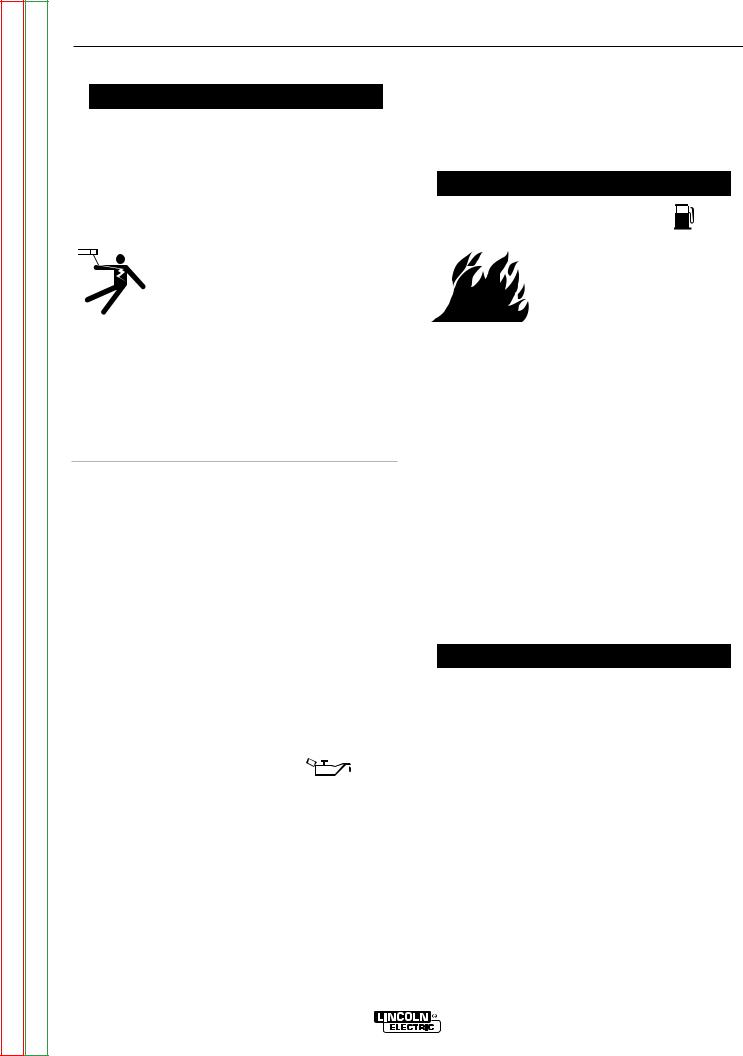
Return to Section TOC |
Return to Master TOC |
Return to Section TOC |
Return to Master TOC |
Return to Section TOC |
Return to Master TOC |
Return to Section TOC |
Return to Master TOC |
B-2 |
THEORY OF OPERATION |
B-2 |
|
SAFETY PRECAUTIONS
 WARNING
WARNING
Do not attempt to use this equipment until you have thoroughly read the engine manufacturer’s manual supplied with your welder. It includes important safety precautions, detailed engine starting, operating and maintenance instructions, and parts lists.
------------------------------------------------------------------------
ELECTRIC SHOCK can kill.
•Do not touch electrically live parts or electrode with skin or wet clothing.
•Insulate yourself from work and ground
•Always wear dry insulating gloves.
•Always operate the welder with the hinged door closed and the side panels in place.
•Read carefully the Safety Precautions page before operating this machine. Always follow these and any other safety procedures included in this manual and in the Engine Instruction Manual.
GENERAL DESCRIPTION
The VANTAGE® 400 is a diesel engine powered DC multi-process welding power source and 120 / 240 volt AC power generator. The engine drives a generator that supplies three phase power for the DC welding circuit, single phase and Three Phase power for the AC auxiliary outlets. The DC welding control system uses
state of the art Chopper Technology (CT™) for superior welding performance.
The Vantage® 400 is fitted with a selectable VRD(Voltage Reduction Device). The VRD operates in the CC-Stick mode reducing the OCV to <13 volts, increasing operator safety when welding is performed in environments with increased hazard of electric shock.
FOR AUXILIARY POWER:
Start the engine and set the IDLER
control switch to the desired operating mode. Full power is available regardless of the welding control settings providing no welding current is being drawn.
ENGINE OPERATION
Before Starting the Engine:
•Be sure the machine is on a level surface.
•Open side engine door and remove the engine oil dipstick and wipe it with a clean cloth. Reinsert the dipstick and check the level on the dipstick.
•Add oil (if necessary) to bring the level up to the full mark. Do not overfill. Close engine door.
•Check radiator for proper coolant level. (Fill if necessary).
•See Engine Owner’s Manual for specific oil and coolant recommendations.
 WARNING
WARNING
ADD FUEL
•Stop engine while fueling.
•Do not smoke when fueling.
•Keep sparks and flame away from tank.
•Do not leave unattended while fueling.
DIESEL FUEL • Wipe up spilled fuel and allow can cause fire. fumes to clear before starting
engine.
•Do not overfill tank, fuel expansion may cause overflow.
DIESEL FUEL ONLY
------------------------------------------------------------------------
•Remove the fuel tank cap.
•Fill the tank. DO NOT FILL THE TANK TO THE POINT OF OVERFLOW.
•Replace the fuel cap and tighten securely.
•See Engine Owner’s Manual for specific fuel recommendations.
BREAK-IN PERIOD
 CAUTION
CAUTION
The engine will use a small amount of oil during its “break-in” period. The break-in period is about 50 running hours.
Check the oil every four hours during break-in. Change the oil after the first 50 hours of operation and every 200 hours thereafter. Change the oil filter at each oil change.
During break-in, subject the Welder to moderate loads. Avoid long periods running at idle. Before stopping the engine, remove all loads and allow the engine to cool several minutes.
------------------------------------------------------------------------
VANTAGE® 400
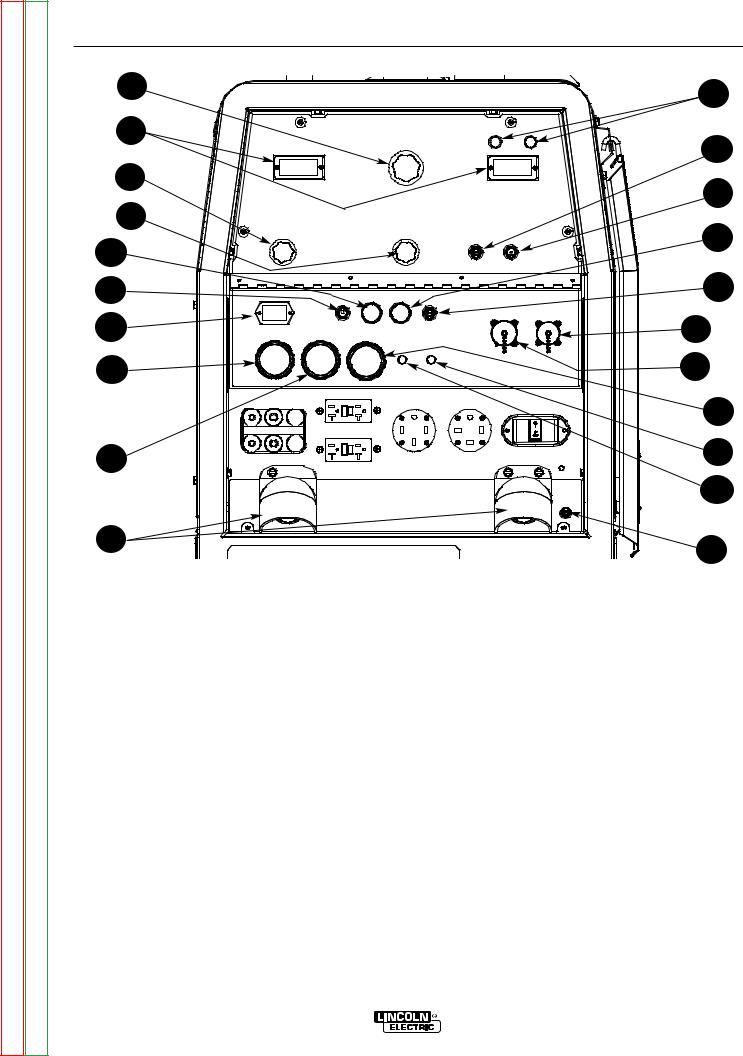
Return to Section TOC |
Return to Master TOC |
Return to Section TOC |
Return to Master TOC |
Return to Section TOC |
Return to Master TOC |
Return to Section TOC |
Return to Master TOC |
B-3 |
THEORY OF OPERATION |
B-3 |
||
|
|
|||
|
FIGURE B.1 |
|
||
1 |
|
|
11 |
|
|
|
|
||
2 |
|
|
9 |
|
|
|
|
||
3 |
|
|
10 |
|
|
|
|
||
4 |
|
|
|
|
13 |
|
|
14 |
|
|
|
|
||
12 |
|
|
15 |
|
17 |
|
8 |
|
|
16 |
|
7 |
|
|
|
|
|
21 |
|
20 |
|
|
18 |
|
|
|
|
||
|
|
|
19 |
|
5 |
|
|
6 |
|
|
|
|
||
WELDING CONTROLS (Figure B.1) |
2. DIGITAL OUTPUT METERS-The digital meters |
|||
|
|
allow the output voltage (CV-WIRE mode) or cur- |
||
1. OUTPUT CONTROL- The OUTPUT dial is used |
rent (CC-STICK,DOWN HILL PIPE and TIG modes) |
|||
to preset the output voltage or current as displayed |
to be set prior to welding using the OUTPUT control |
|||
dial. During welding, the meter display the actual |
||||
on the digital meters for the four welding modes. |
||||
output voltage (VOLTS) and current (AMPS). A |
||||
When in the CC-STICK, DOWNHILL PIPE or CV- |
||||
memory feature holds the display of both meters on |
||||
WIRE modes and when a remote control is connect- |
||||
for seven seconds after welding is stopped. This |
||||
ed to the 6-Pin or 14-Pin Connector, the auto-sens- |
||||
allows the operator to read the actual current and |
||||
ing circuit |
automatically switches the OUTPUT |
|||
voltage just prior to when welding was ceased. |
||||
CONTROL from control at the welder to the remote |
||||
|
|
|||
control. |
|
While the display is being held the left-most deci- |
||
|
|
|||
In the CV-WIRE mode, if the feeder being used has |
mal point in each display will be flashing. The accu- |
|||
racy of the meters is +/- 3%. |
|
|||
a voltage control when the wire feeder control cable |
|
|||
|
|
|||
is connected to the 14-Pin Connector, the auto-sens- |
3. WELD MODE SELECTOR SWITCH- |
|
||
ing circuit automatically makes OUTPUT CONTROL |
|
|||
inactive and the wire feeder voltage control active. |
(Provides four selectable welding modes) |
|
||
Otherwise, the OUTPUT CONTROL is used to pre- |
CV-WIRE |
|
||
set the voltage |
DOWNHILL PIPE |
|
||
|
|
CC-STICK |
|
|
When in the TOUCH START TIG mode and when an |
TOUCH START TIG |
|
||
|
|
|||
Amptrol is |
connected to the 6-Pin Connector, the |
|
|
|
OUTPUT dial is used to set the maximum current |
|
|
||
range of the CURRENT CONTROL of the Amptrol. |
|
|
||
VANTAGE® 400
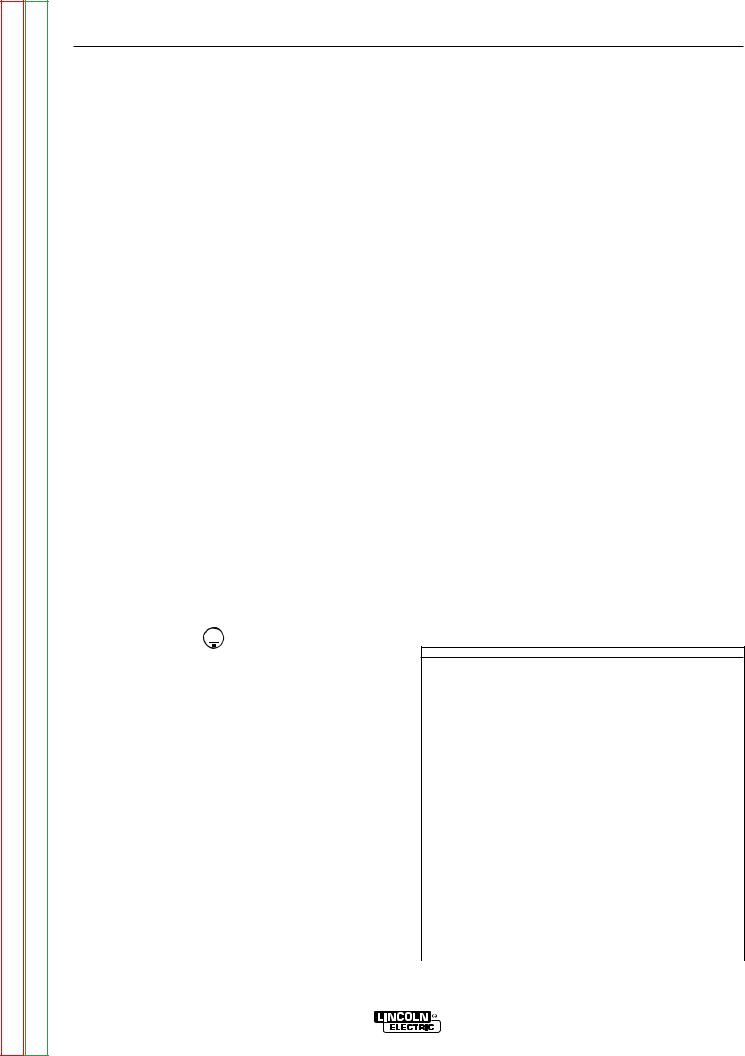
Return to Section TOC |
Return to Master TOC |
Return to Section TOC |
Return to Master TOC |
Return to Section TOC |
Return to Master TOC |
Return to Section TOC |
Return to Master TOC |
B-4 |
THEORY OF OPERATION |
B-4 |
|
4. ARC CONTROL- The ARC CONTROL dial is active in the CV-WIRE, CC-STICK and DOWNHILL PIPE modes, and has different functions in these modes. This control is not active in the TIG mode.
CC-STICK mode: In this mode, the ARC CONTROL dial sets the short circuit current (arc-force) during stick welding to adjust for a soft or crisp arc. Increasing the dial from –10 (soft) to +10 (crisp) increases the short circuit current and prevents sticking of the electrode to the plate while welding. This can also increase spatter. It is recommended that the ARC CONTROL be set to the minimum number without electrode sticking. Start with a setting at 0.
DOWNHILL PIPE mode: In this mode, the ARC CONTROL dial sets the short circuit current (arc-force) during stick welding to adjust for a soft or a more forceful digging arc (crisp). Increasing the number from –10 (soft) to +10 (crisp) increases the short circuit current which results in a more forceful digging arc. Typically a forceful digging arc is preferred for root and hot passes. A softer arc is preferred for fill and cap passes where weld puddle control and deposition ("stacking" of iron) are key to fast travel speeds. It is recommended that the ARC CONTROL be set initially at 0.
CV-WIRE mode: In this mode, turning the ARC CONTROL clock wise from –10 (soft) to +10 (crisp) changes the arc from soft and washed-in to crisp and narrow. It acts as an inductance/pinch control. The proper setting depends on the procedure and operator preference. Start with a setting of 0.
5. WELD OUTPUT TERMINALS WITH FLANGE NUT-
work cables.
6. GROUND STUD-  Provides a connection point for connecting the machine case to earth ground.
Provides a connection point for connecting the machine case to earth ground.
7. 14-PIN CONNECTOR- For attaching wire feeder control cables. Includes contactor closure circuit, auto-sensing remote control circuit, and 120V and 42V power. The remote control circuit operates the same as the 6 Pin Amphenol.
8. 6-PIN CONNECTOR- For attaching optional remote control equipment. Includes auto-sensing remote control circuit.
9. WELD TERMINALS CONTROL SWITCH- In the WELD TERMINALS ON position, the output is electrically hot all the time. In the REMOTELY CONTROLLED position, the output is controlled by a wire feeder or amptrol device, and is electrically off until a remote switch is depressed.
10. WIRE FEEDER VOLTMETER SWITCH:
Matches the polarity of the wire feeder voltmeter to the polarity of the electrode.
11. VRD (Voltage Reduction Device) INDICATOR LIGHTS- On the front panel of the Vantage 400 are two indicator lights. A red light when lit indicates OCV(Open Circuit Voltage) is equal to or greater than 30V and a green light when lit indicates
OCV(Open Circuit Voltage) is less than 30V.
The VRD “On/Off” switch inside the control panel must be “On” for the VRD function to be active and the lights to be enabled. When the machine is first started with VRD enabled, both lights will illuminate for 5 seconds.
These lights monitor the OCV(Open Circuit Voltage) and weld voltage at all times. In the CC-Stick mode when not welding the green light will illuminate indicating that the VRD has reduced the OCV to less than 30V. During welding the red light will illuminate whenever the arc voltage is equal to or greater than 30V. This means that the red and green light may alternate depending on the weld voltage. This is normal operation.
If the red light remains illuminated when not welding in the CC-stick mode, the VRD is not functioning properly. Please refer to your local field service shop for service.
If the VRD is turned “On” and the lights don’t come “On”, refer to the trouble shooting section.
TABLE B.1
VRD INDICATOR LIGHTS
MODE |
|
VRD "ON" |
VRD "OFF" |
|
CC-STICK |
|
OCV |
Green (OCV Reduced) |
|
|
|
While |
Red or Green |
|
|
|
Welding |
(Depends on Weld Voltage) * |
|
CV-WIRE |
|
OCV |
Red (OCV Not Reduced) |
|
|
|
|
Weld Terminals On |
|
|
|
|
Red (OCV Not Reduced) |
|
|
|
|
Weld Terminals Remotely Controlled |
|
|
|
|
Gun Trigger Closed |
|
|
|
|
Green (No OCV) |
|
|
|
|
Weld Terminals Remotely Controlled |
|
|
|
|
Gun Trigger Open |
No Lights |
|
|
While |
Red or Green |
|
|
|
Welding |
(Depends on Weld Voltage) * |
|
PIPE |
|
OCV |
Green (No Output) |
|
|
|
While |
Not Applicable (No Output) |
|
|
|
Welding |
|
|
ARC GOUGING |
OCV |
Green (No Output) |
|
|
|
|
While |
Not Applicable (No Output) |
|
|
|
Welding |
|
|
TIG |
|
OCV |
Green (Process is Low Voltage) |
|
|
|
While |
Green (Process is Low Voltage) |
|
|
|
Welding |
|
|
|
|
|
|
|
* It is normal for the lights to alternate between colors while welding.
VANTAGE® 400
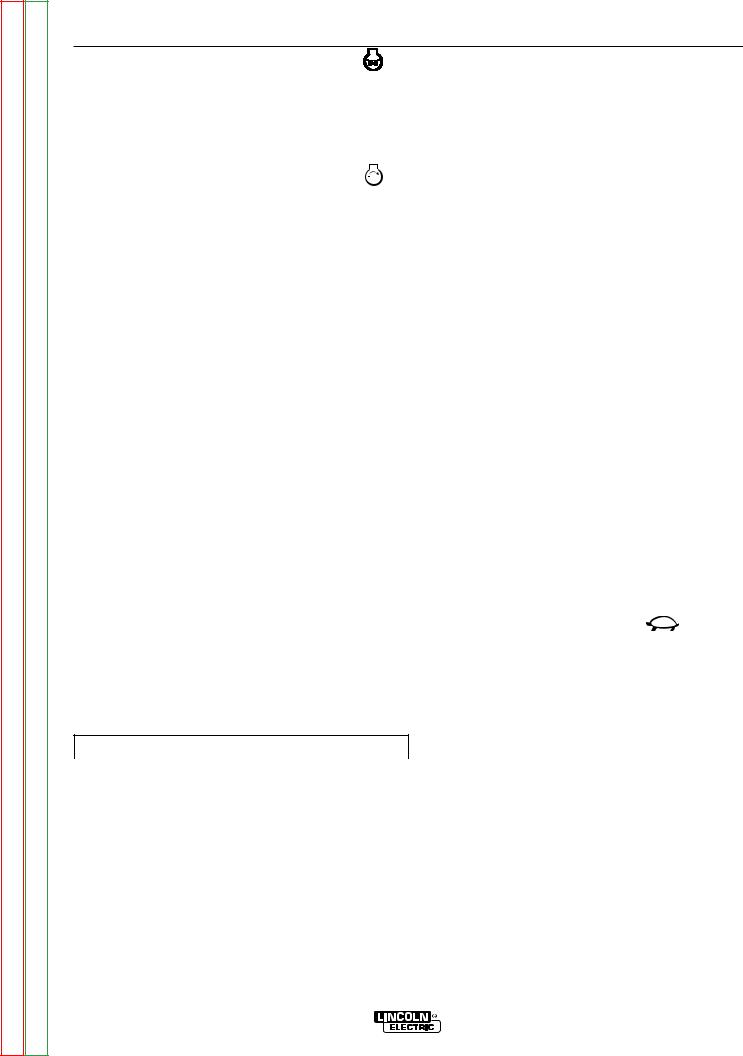
Return to Section TOC |
Return to Master TOC |
Return to Section TOC |
Return to Master TOC |
Return to Section TOC |
Return to Master TOC |
Return to Section TOC |
Return to Master TOC |
B-5 |
THEORY OF OPERATION |
B-5 |
|
ENGINE CONTROLS:
12. RUN/STOP SWITCH - RUN position energizes the engine prior to starting. STOP position stops the engine. The oil pressure interlock switch prevents battery drain if the switch is left in the RUN position and the engine is not operating.
13. GLOW PLUG PUSH BUTTON -
•When pushed activates the glow plugs. Glow plug should not be activated for more than 20 seconds continuously.
14. START PUSH BUTTON - Energizes the starter motor to crank the engine.
15.IDLER SWITCH- Has two positions as follows:
1)In the HIGH position, the engine runs at the high idle speed controlled by the engine governor.
2)In the AUTO position, the idler operates as follows:
•When switched from HIGH to AUTO or after starting the engine, the engine will operate at full speed for approximately 12 seconds and then go to low idle speed.
•When the electrode touches the work or power is drawn for lights or tools (approximately 100 Watts minimum), the engine accelerates and operates at full speed.
•When welding ceases or the AC power load is turned off, a fixed time delay of approximately 12 seconds starts. If the welding or AC power load is not restarted before the end of the time delay, the idler reduces the engine speed to low idle speed.
•The engine will automatically return to high idle speed when there is welding load or AC power load reapplied.
16.ELECTRIC FUEL GAUGE- The electric fuel gauge
gives accurate and reliable indication as to how much fuel is in the fuel tank.
17. ENGINE HOUR METER- Displays the total time that the engine has been running. This meter is useful for scheduling prescribed maintenance.
TABLE B.2
TYPICAL VANTAGE® 400 FUEL CONSUMPTION
|
PERKINS |
Running Time for |
|
|
Gal./Hr (Liters/Hr) |
15 gallons / hours |
|
|
|
|
|
Low Idle - No Load |
|
|
|
1400 R.P.M. |
.26 |
(.97) |
58.59 |
High Idle - No Load |
|
|
|
1880 R.P.M. |
.42 (1.57) |
36.06 |
|
DC Weld Output |
|
|
|
400 Amps @ 36 Volts |
1.18 |
(4.46) |
12.74 |
17,000 Watts 3 Phase |
1.24 |
(4.68) |
12.14 |
11,000 Watts 1 Phase |
.90 (3.42) |
16.62 |
|
|
|
|
|
NOTE: This data is for reference only. Fuel consumption is approximate and can be influenced by many factors, including engine maintenance, environmental conditions and fuel quality.
18. ENGINE PROTECTION LIGHT- A warning indicator light for Low Oil Pressure and/or Coolant Over Temperature.The light is off when the systems are functioning properly. The light will come on and the engine will shutdown when there is Low Oil Pressure and/or the Coolant is Over Temperature.
Note: The light remains off when the RUN-STOP switch is in the "ON" position prior to starting the engine. However if the engine is not started within 60 seconds the light will come on. When this happens the RUNSTOP switch must be returned to the "OFF" position to reset the engine protection system and light.
19. BATTERY CHARGING LIGHT- A warning indicator light for Low/No battery charge. The light is off when the systems are functioning properly. The light will come on if there is a Low/No battery condition but the machine will continue to run.
Note: The light may or may not come on when the RUNSTOP switch is in the "ON" position. It will come on during cranking and stay on until the engine starts. After starting the engine the light will go off unless a Low/No battery charge condition exists.
20. COOLANT TEMPERATURE GAUGE-A indicator of engine coolant temperature.
21. OIL PRESSURE GAUGE- A indicator of engine Oil Pressure.
STARTING THE ENGINE
1.Remove all plugs connected to the AC power receptacles.
2.Set IDLER switch to AUTO. 

3.Press Glow Plug Button and hold 15 to 20 seconds.
4.Set the RUN/STOP switch to RUN.
5. |
Press START button until the engine starts or for up to |
|
10 seconds. Continue to hold the glow plug button for up |
|
to an additional 10 seconds. |
6. |
Release the engine START button immediately when the |
|
engine starts. |
7.The engine will run at high idle speed for approximately 12 seconds and then drop to low idle speed. Allow the engine to warm up at low idle for several minutes before applying a load and/or switching to high idle. Allow a longer warm up time in cold weather.
VANTAGE® 400

Return to Section TOC |
Return to Master TOC |
Return to Section TOC |
Return to Master TOC |
Return to Section TOC |
Return to Master TOC |
Return to Section TOC |
Return to Master TOC |
B-6 |
THEORY OF OPERATION |
B-6 |
|
NOTE: If the unit fails to start turn Run/Stop switch to off and repeat step 3 through step 7 after waiting 30 seconds.
 CAUTION
CAUTION
•Do not allow the starter motor to run continuously for more than 20 seconds.
•Do not push the START button while the engine is running because this can damage the ring gear and/or the starter motor.
•IF the Engine Protection or Battery Charging Lights do “not” turn off shortly after starting the engine shut off the engine immediately and determine the cause.
-----------------------------------------------------------------------
NOTE: When starting for the first time, or after an extended period of time of not operating, it will take longer than normal to start because the fuel pump has to fill the fuel system. For best results, bleed the fuel system as indicated in the Maintenance Section of this manual.
STOPPING THE ENGINE
Remove all welding and auxiliary power loads and allow the engine to run at low idle speed for a few minutes to cool the engine.
STOP the engine by placing the RUN-STOP switch in the STOP position.
NOTE: A fuel shut off valve is located on the fuel prefilter.
WELDER OPERATION
DUTY CYCLE
Duty Cycle is the percentage of time the load is being applied in a 10 minute period. For example a 60% duty cycle, represents 6 minutes of load and 4 minutes of no load in a 10 minute period.
ELECTRODE INFORMATION
For any electrode the procedures should be kept within the rating of the machine. For information on electrodes and their proper application see (www.lincolnelectric.com) or the appropriate Lincoln publication.
The VANTAGE® 400 can be used with a broad range of DC stick electrodes. The MODE switch provides two stick welding settings as follows:
The ARC CONTROL dial sets the short circuit current (arc-force) during stick welding to adjust for a soft or crisp arc. Increasing the number from -10(soft) to +10(crisp) increases the short circuit current and prevents sticking of the electrode to the plate while welding. This can also increase spatter. It is recommended that the ARC CONTROL be set to the minimum number without electrode sticking. Start with the dial set at 0.
NOTE: Due to the low OCV with the VRD on, a very slight delay during striking of the electrodes may occur. Due to the requirement of the resistance in the circuit to be low for a VRD to operate, a good metal-to-metal contact must be made between the metal core of the electrode and the job. A poor connection anywhere in the welding output circuit may limit the operation of the VRD. This includes a good connection of the work clamp to the job. The work clamp should be connected as close as practical to where the welding will be performed.
A. For New Electrodes
E6010 - Touch, Lift to Start the Arc
E7018, E7024 - Touch, Rock Back and Forth in Joint, Lift .
Once the arc is started, normal welding technique for the application is then used.
B. For Re-Striking Electrodes
Some electrodes form a cone at the end of the electrode after the welding arc has been broken, particularly iron powder and low hydrogen electrodes. This cone will need to be broken off in order to have the metal core of the electrode make contact.
E6010 - Push, Twist in Joint, Lift
E7018, E7024 - Push, Rock Back and Forth in
Joint, Lift.
Once the arc is started, normal welding technique for the application is then used.
For other electrodes the above techniques should be tried first and varied as needed to suit operator preference. The goal for successful starting is good metal to metal contact.
For indicator light operation, see Table B.1.
DOWNHILL PIPE Welding
CONSTANT CURRENT (CC-STICK) WELDING |
This slope controlled setting is intended for "out-of- |
|||
|
|
|
||
The CC-STICK position of the MODE switch is designed |
position" and "down hill" pipe welding where the oper- |
|||
ator would like to control the current level by changing |
||||
for horizontal and vertical-up welding with all types of |
||||
the arc length. |
||||
electrodes, especially low hydrogen. The OUTPUT CON- |
||||
|
||||
TROL dial adjusts the full output range for stick welding. |
|
|||
VANTAGE® 400 |
||||
|
|
|
|
|
|
|
|
|
|
|
|
|
|
|
|
|
|
|
|

Return to Section TOC |
Return to Master TOC |
Return to Section TOC |
Return to Master TOC |
Return to Section TOC |
Return to Master TOC |
Return to Section TOC |
Return to Master TOC |
B-7 |
THEORY OF OPERATION |
B-7 |
|
The OUTPUT CONTROL dial adjusts the full output range for pipe welding.
The ARC CONTROL dial sets the short circuit current (arc-force) during stick welding to adjust for a soft or more forceful digging arc (crisp). Increasing the number from - 10(soft) to +10(crisp) increases the short circuit current which results in a more forceful digging arc.
Typically a forceful digging arc is preferred for root and hot passes. A softer arc is preferred for fill and cap passes where weld puddle control and deposition (“stacking” of iron) are key to fast travel speeds. This can also increase spatter.
It is recommended that the ARC CONTROL be set to the minimum number without electrode sticking. Start with the dial set at 0.
NOTE: With the VRD switch in the “ON” position there is no output in the DOWNHILL PIPE mode. For indicator light operation, see Table B.1.
TIG WELDING
The TOUCH START TIG setting of the MODE switch is for DC TIG (Tungsten Inert Gas) welding. To initiate a weld, the OUTPUT CONTROL dial is first set to the desired current and the tungsten is touched to the work. During the time the tungsten is touching the work there is very little voltage or current and, in general, no tungsten contamination. Then, the tungsten is gently lifted off the work in a rocking motion, which establishes the arc.
When in the TOUCH START TIG mode and when a Amptrol is connected to the 6-Pin connector the OUTPUT CONTROL dial is used to set the maximum current range of the current control of the Amptrol.
The ARC CONTROL is not active in the TIG mode. To STOP a weld, simply pull the TIG torch away from the work.
When the arc voltage reaches approximately 30 Volts the arc will go out and the machine will reset the current to the Touch Start level.
To reinitiate the arc, retouch the tungsten to the work and lift. Alternatively, the weld can be stopped by releasing the Amptrol or arc start switch.
The VANTAGE® 400 can be used in a wide variety of DC TIG welding applications. In general the ‘Touch Start’ feature allows contamination free starting without the use of a Hi-frequency unit. If desired, the K930-2 TIG Module can be used with the VANTAGE® 400. The settings are for reference.
VANTAGE® 400 settings when using the K930-2 TIG Module with an Amptrol or Arc Start Switch:
•Set the MODE Switch to the TOUCH START TIG setting.
•Set the "IDLER" Switch to the "AUTO" position.
TABLE B.3
TYPICAL CURRENT RANGES (1) FOR TUNGSTEN ELECTRODES(2)
Tungsten Electrode |
DCEN (-) |
DCEP (+) |
Approximate Argon Gas Flow |
|
TIG TORCH |
|
||||
Diameter in. (mm) |
|
|
Flow Rate C.F.H. ( l |
/min.) |
|
Nozzle Size (4), (5) |
||||
|
|
|
|
|
|
|
|
|
|
|
|
|
1%, 2% Thoriated |
1%, 2% Thoriated |
Aluminum |
|
|
Stainless Steel |
|
|
|
|
|
Tungsten |
Tungsten |
|
|
|
|
|
|
|
|
|
|
|
|
|
|
|
|
|
|
0.010 |
(.25) |
2-15 |
(3) |
3-8 |
(2-4) |
|
3-8 |
(2-4) |
#4, #5, #6 |
|
0.020 |
(.50) |
5-20 |
(3) |
5-10 |
(3-5) |
|
5-10 |
(3-5) |
|
|
0.040 |
(1.0) |
15-80 |
(3) |
5-10 |
(3-5) |
|
5-10 |
(3-5) |
|
|
1/16 |
(1.6) |
70-150 |
10-20 |
5-10 |
(3-5) |
|
9-13 |
(4-6) |
#5, #6 |
|
3/32 |
(2.4) |
150-250 |
15-30 |
13-17 |
(6-8) |
|
11-15 |
(5-7) |
#6, #7, #8 |
|
1/8 |
(3.2) |
250-400 |
25-40 |
15-23 |
(7-11) |
|
11-15 |
(5-7) |
|
|
5/32 |
(4.0) |
400-500 |
40-55 |
21-25 |
(10-12) |
|
13-17 |
(6-8) |
#8, #10 |
|
3/16 |
(4.8) |
500-750 |
55-80 |
23-27 |
(11-13) |
|
18-22 |
(8-10) |
|
|
1/4 |
(6.4) |
750-1000 |
80-125 |
28-32 |
(13-15) |
|
23-27 |
(11-13) |
|
|
|
|
|
|
|
|
|
|
|
|
|
(1)When used with argon gas. The current ranges shown must be reduced when using argon/helium or pure helium shielding gases.
(2)Tungsten electrodes are classified as follows by the American Welding Society (AWS):
Pure |
EWP |
1% Thoriated |
EWTh-1 |
2% Thoriated |
EWTh-2 |
Though not yet recognized by the AWS, Ceriated Tungsten is now widely accepted as a substitute for 2% Thoriated Tungsten in AC and DC applications.
(3)DCEP is not commonly used in these sizes.
(4)TIG torch nozzle "sizes" are in multiples of 1/16ths of an inch:
# 4 = 1/4 in. |
(6 mm) |
|
# 5 |
= 5/16 in. |
(8 mm) |
# 6 |
= 3/8 in. |
(10 mm) |
# 7 |
= 7/16 in. |
(11 mm) |
# 8 |
= _ in. |
(12.5 mm) |
#10 = 5/8 in. |
(16 mm) |
|
(5)TIG torch nozzles are typically made from alumina ceramic. Special applications may require lava nozzles, which are less prone to breakage, but cannot withstand high temperatures and high duty cycles.
VANTAGE® 400

Return to Section TOC |
Return to Master TOC |
Return to Section TOC |
Return to Master TOC |
Return to Section TOC |
Return to Master TOC |
Return to Section TOC |
Return to Master TOC |
B-8 |
THEORY OF OPERATION |
B-8 |
|
•Set the "WELDING TERMINALS" switch to the "REMOTELY CONTROLLED" position. This will keep the "Solid State" contactor open and provide a "cold" electrode until the Amptrol or Arc Start Switch is pressed.
When using the TIG Module, the OUTPUT CONTROL on the VANTAGE® 400 is used to set the maximum range of the CURRENT CONTROL on the TIG Module or an Amptrol if connected to the TIG Module.
NOTE: The TIG process is to receive a low voltage welding process. There is no difference in operation with the VRD “On” or “Off” for this mode. For indicator light operation, see Table B.1.
WIRE WELDING-CV
Connect a wire feeder to the VANTAGE® 400 according to the instructions in INSTALLATION INSTRUCTIONS Section.
The VANTAGE® 400 in the CV-WIRE mode, permits it to be used with a broad range of flux cored wire (Innershield and Outershield) electrodes and solid wires for MIG welding (gas metal arc welding). Welding can be finely tuned using the ARC CONTROL. Turning the ARC CONTROL clockwise from –10 (soft) to +10 (crisp) changes the arc from soft and washed-in to crisp and narrow. It acts as an inductance/pinch control. The proper setting depends on the procedure and operator preference. Start with the dial set at 0.
NOTE: In the CV-Mode with VRD “On”, the OCV(Open Circuit Voltage) is not reduced. For indicator light operation, see Table B.1.
TABLE B.5
ARC GOUGING
The VANTAGE® 400 can be used for arc gouging. For optimal performance, set the MODE switch to CC-STICK and the ARC CONTROL to +10.
Set the OUTPUT CONTROL knob to adjust output current to the desired level for the gouging electrode being used according to the ratings in the following Table B.4.
|
TABLE B.4 |
|
|
|
|
Carbon Diameter |
|
Current Range (DC, electrode |
|
|
positive) |
1/8" |
|
60-90 Amps |
5/32" |
|
90-150 Amps |
3/16" |
|
200-250 Amps |
1/4" |
|
300-400 Amps |
|
|
|
5/16” |
|
450-550 Amps |
|
|
|
AUXILIARY POWER:
Start the engine and set the IDLER control switch to the desired operating mode. Full power is available regardless of the welding control settings providing no welding current is being drawn.
Simultaneous Welding and Auxiliary Power Loads
The auxiliary power ratings are with no welding load. Simultaneous welding and power loads are specified in the following table.
|
|
|
|
|
|
|
|
|
|
|
|
|
|
|
|
|
|
|
|
|
|
|
|
|
VANTAGE® 400 Simultaneous Welding and Power Loads |
|
|
|
|
||||||||||
|
Weld |
|
|
|
|
|
|
|
|
|
|
|
|
|
|
|
|
||
|
|
|
|
|
|
|
|
|
|
|
|
|
|
|
|
|
|||
|
|
|
|
1 PHASE |
|
3 PHASE |
|
|
|||||||||||
|
|
|
|
|
|
|
|
|
|
BOTH 1 & 3 PHASE |
|||||||||
|
Amps |
|
|
|
WATTS |
AMPS |
|
|
WATTS |
AMPS |
|
|
WATTS |
AMPS |
|
||||
|
0 |
|
|
|
11,000 |
46 |
|
|
|
17,000 |
41 |
|
|
|
11,000 |
- |
|
|
|
|
100 |
|
|
11,000 |
46 |
|
|
15,400 |
37 |
|
|
11,000 |
- |
|
|
||||
|
200 |
PLUS |
8,000 |
33 |
|
OR |
13,000 |
31 |
|
OR |
8,000 |
- |
|
|
|||||
|
300 |
|
|
4700 |
20 |
|
|
9400 |
23 |
|
|
4,700 |
- |
|
|
||||
|
400 |
|
|
1700 |
7 |
|
|
3400 |
8 |
|
|
1,700 |
- |
|
|
||||
|
500 |
|
|
0 |
0 |
|
|
0 |
0 |
|
|
0 |
|
0 |
|
|
|||
|
|
|
|
|
|
|
|
|
|
|
|
|
|
|
|
|
|
|
|
|
|
|
|
|
|
|
|
|
|
|
|
|
|
|
|
|
|
|
|
TABLE B.6
VANTAGE® 400 (CE) Extension Cord Length Recommendations
(Use the shortest length extension cord possible sized per the following table.)
Current |
Voltage |
Load |
|
|
Maximum Allowable Cord Length in ft. (m) for Conductor Size |
|
|
|||||||
(Amps) |
Volts |
(Watts) |
14 AWG |
12 AWG |
10 AWG |
8 AWG |
6 AWG |
4 AWG |
||||||
15 |
120 |
1800 |
30 |
(9) |
40 |
(12) |
75 |
(23) |
125 |
(38) |
175 |
(53) |
300 |
(91) |
20 |
120 |
2400 |
|
|
30 |
(9) |
50 |
(15) |
88 |
(27) |
138 |
(42) |
225 |
(69) |
15 |
240 |
3600 |
60 |
(18) |
75 |
(23) |
150 |
(46) |
225 |
(69) |
350 |
(107) |
600 |
(183) |
20 |
240 |
4800 |
|
|
60 |
(18) |
100 |
(30) |
175 |
(53) |
275 |
(84) |
450 |
(137) |
44 |
240 |
9500 |
|
|
|
|
50 |
(15) |
90 |
(27) |
150 |
(46) |
225 |
(69) |
|
|
|
|
Conductor size is based on maximum 2.0% voltage drop. |
|
|
|
|
||||||
|
|
|
|
|
|
|
|
|
|
|
|
|
|
|
|
|
|
|
|
|
|
|
|
|
|
|
|
|
|
VANTAGE® 400

Return to Master TOC
Return to Master TOC
Return to Master TOC
Return to Master TOC
C-1 |
TABLE OF CONTENTS - ACCESSORIES SECTION |
C-1 |
|
||
|
|
|
Accessories . . . . . . . . . . . . . . . . . . . . . . . . . . . . . . . . . . . . . . . . . . . . . . . . . . . . . . . . . . . . . . . . . . . . . . . . . . . .C-1
Factory Installed Options / Accessories . . . . . . . . . . . . . . . . . . . . . . . . . . . . . . . . . . . . . . . . . . . . . . . . . . . .C-2 Connection Diagrams . . . . . . . . . . . . . . . . . . . . . . . . . . . . . . . . . . . . . . . . . . . . . . . . . . . . . . . . . . . . .C-3 / C-7 Engine Welders/LN25 Across the Arc with Optional K857 Remote Control . . . . . . . . . . . . . . . . . . . . .C-3 Engine Welders/LN25 Across the Arc with Optional K444-1 Remote Control . . . . . . . . . . . . . . . . . . .C-3 Engine Welders/LN25 with K624-1 42 Volt Remote Output Control Module . . . . . . . . . . . . . . . . . . . .C-4 Engine Welders / LN7 . . . . . . . . . . . . . . . . . . . . . . . . . . . . . . . . . . . . . . . . . . . . . . . . . . . . . . . . . . . . . .C-4 Engine Welders / LN742 . . . . . . . . . . . . . . . . . . . . . . . . . . . . . . . . . . . . . . . . . . . . . . . . . . . . . . . . . . . .C-5 Engine Welders / LN8 . . . . . . . . . . . . . . . . . . . . . . . . . . . . . . . . . . . . . . . . . . . . . . . . . . . . . . . . . . . . . .C-5 Engine Welders to K867 Control Cable Adapter . . . . . . . . . . . . . . . . . . . . . . . . . . . . . . . . . . . . . . . . . .C-6 Engine Welders / K691-10 / K488 / K487 Spool Gun . . . . . . . . . . . . . . . . . . . . . . . . . . . . . . . . . . . . . .C-6
Engine Welders / K930 TIG Module . . . . . . . . . . . . . . . . . . . . . . . . . . . . . . . . . . . . . . . . . . . . . . . . . . .C-7 Engine Welders / K1587-1 CobraMatic . . . . . . . . . . . . . . . . . . . . . . . . . . . . . . . . . . . . . . . . . . . . . . . . .C-7
VANTAGE® 400

Return to Section TOC |
Return to Master TOC |
Return to Section TOC |
Return to Master TOC |
Return to Section TOC |
Return to Master TOC |
Return to Section TOC |
Return to Master TOC |
C-2 |
ACCESSORIES |
C-2 |
|
FIELD INSTALLED OPTIONS / ACCESSORIES
K2641-2 FOUR WHEELED STEERABLE YARD TRAILER
For in plant and yard towing. Comes standard with a Duo-Hitch™, a 2” Ball and Lunette Eye combination Hitch.
K2636-1 TRAILER - Two-wheeled trailer with optional fender and light package. For highway use, consult applicable federal, state, and local laws regarding possible additional requirements. Comes standard with a Duo-Hitch™, a 2” Ball and Lunette Eye combination hitch. Order:
K2636-1 Trailer
K2639-1 Fender & Light Kit
K2640-1 Cable Storage Rack
K903-1 SPARK ARRESTOR - Includes a heavy gage steel, approved spark arrestor, clamp and adapter for mounting to the muffler exhaust pipe.
K704 ACCESSORY SET - Includes 35 ft. (10m) of electrode cable and 30 ft. (9.1m) of work cable, head shield, work clamp electrode holder. Cables are rated at 400 amps, 100% duty cycle.
K857 25 ft (7.6m) or K857-1 100 ft. (30.4m) REMOTE CONTROL Portable control provides same dial range as the output control on the welder. Has a convenient 6 pin plug for easy connection to the welder.
K802N POWER PLUG KIT
Provides four 120 volt plugs rated at 20 amps each and one dual voltage, full KVA plug rated at 120/240 volts, 50 amps.
K802R POWER PLUG KIT
Provides four 120 volt plugs rated at 15 amps each and one dual voltage, full KVA plug rated at 120/240 volts, 50 amps.
T12153-9 50 AMP, 120/240V POWER PLUG (1-Phase) T12153-10 50 AMP, 240V POWER PLUG (3-Phase)
K1816-1 FULL KVA ADAPTER KIT
Plugs into the 120/240V NEMA 14-50R receptacle on the case front (which accepts 4-prong plugs) and converts it to a NEMA 6-50R receptacle, (which accepts 3-prong plugs.) For connection of Lincoln equipment with NEMA 6-50 Plug.
WIRE FEEDER OPTIONS
K449 LN-25 - Includes internal contactor for across the arc operation (no control cable). Provides “cold” electrode until gun trigger is pressed. Includes gas solenoid.
K1870-1 LN-15 Across the Arc Wire Feeder.
Portable, lightweight, compact CC/CV unit for flux-cored and MIG welding. Includes Gas Solenoid, adjustable flow meter and internal contactor. For 10-15 lb. (4.5-6.8kg) spools.
Magnum Gun and Magnum Gun Connector Kit are required for gas-shielded welding. Innershield Gun is required for gasless welding.
K126-2 Magnum 350 Innershield Gun K1802-1 Magnum 300 MIG Gun (for LN-25)
K470-2 Magnum 300 MIG Gun (for LN-15, Includes Connector Kit)
K466-10 Connector Kit (for LN-15, K470-2)
K1500-1 Gun Receiver Bushing (for LN-15 & K126-2)
K487-25 Magnum SG Spool Gun
Hand held semiautomatic wire feeder. Requires SG Control Module and Input Cable.
K488 SG Control Module (For Magnum Spool Gun)
The Interface between the power source and the spool gun. Provides control of the wire speed and gas flow. For use with a K487-25 spool gun.
K691-10 Input Cable (For SG Control Module)
For Lincoln engine power sources with 14-pin MS-type connection, separate 115V NEMA receptacles and output stud connections.
Note: See Wire Feeder IM manuals for appropriate Drive Roll and Guide Tubes.
TIG OPTIONS
K1783-9 Pro -Torch® PTA-26V TIG Torch
Air Cooled 200 amp torch (2 piece) equipped with valve for gas flow control. 25 ft. (7.6m) length.
KP509 Magnum Parts Kit for PTA-26V TIG Torch
Magnum Parts Kit provides all the torch accessories you need to start welding. Parts kit provides collets, collet bodies, a black cap, alumina nozzles and tungstens in a variety of sizes, all packaged in an easy to carry reclosable sack.
K1858-1 SERVICE INDICATOR KIT- Provides a GO / NO-GO visual indication of air cleaner element useful service life. Filter service based on restriction readings allows the longest life possible from the filter and best engine protection.
K2679-1 COLD WEATHER HEATER AND TARP KIT
For engine starting and operation in extreme cold weather conditions down to -40ºF / -40ºC (with the use of OW40 synthetic oil and arctic diesel fuel), includes 120VAC engine block heater, and radiator grill tarp.
K870 Foot Amptrol®
K963-3 Hand Amptrol®
K2347-1 Precision TIG 185 Ready-Pak(For AC TIG)
K2350-1 Invertec® V205-T AC/DC One-Pak™ Package
(For AC TIG)
PLASMA CUTTING
K1580-1 Pro-Cut 55
Cuts metal using the 3-phase AC generator power from the engine driven welder. Accepts 3-phase or 1-phase input power. Requires the K1816-1 Full KVA adapter kit, if connected for 1-phase input power.
VANTAGE® 400
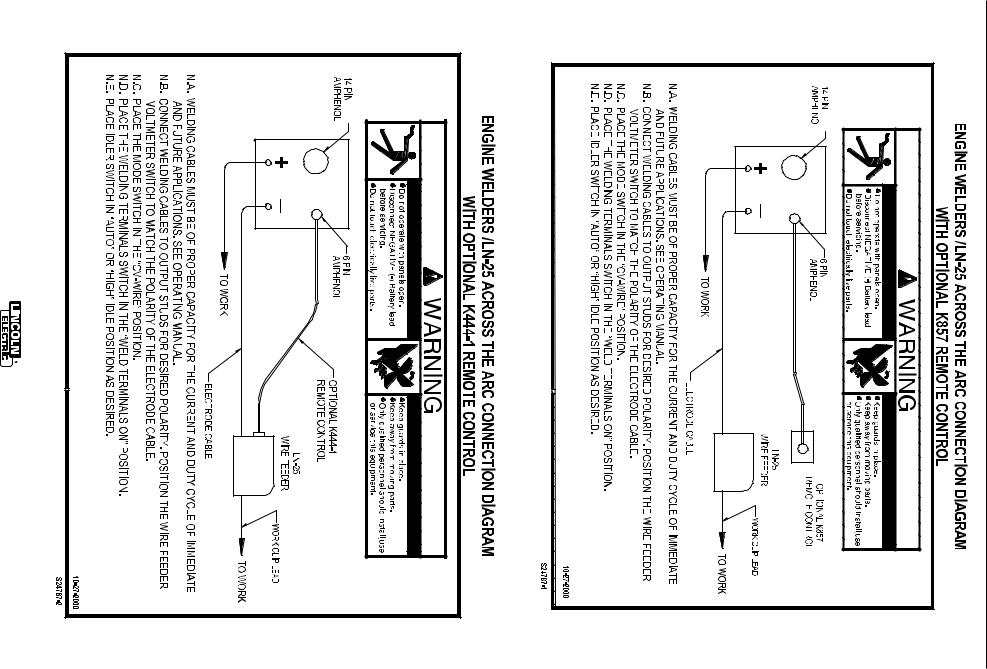
Return to Section TOC |
Return to Section TOC |
Return to Section TOC |
Return to Section TOC |
|
|
|
|
Return to Master TOC |
Return to Master TOC |
Return to Master TOC |
Return to Master TOC |
|
|
|
|
|
|
|
3-C |
400 VANTAGE® |
ACCESSORIES |
3-C
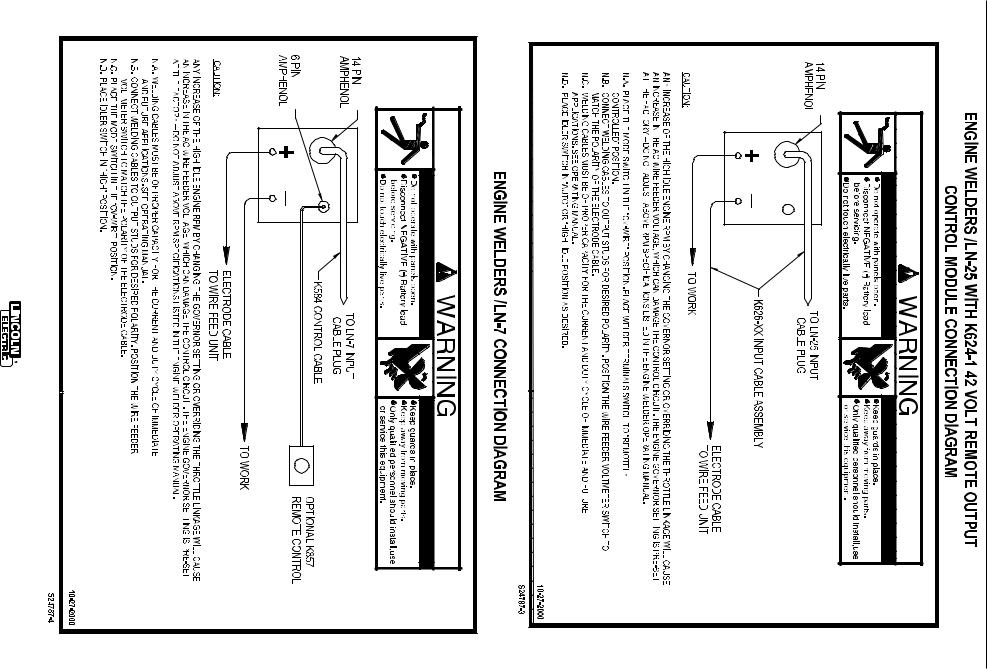
Return to Section TOC |
Return to Section TOC |
Return to Section TOC |
Return to Section TOC |
|
|
|
|
Return to Master TOC |
Return to Master TOC |
Return to Master TOC |
Return to Master TOC |
|
|
|
|
|
|
|
4-C |
400 VANTAGE® |
ACCESSORIES |
4-C
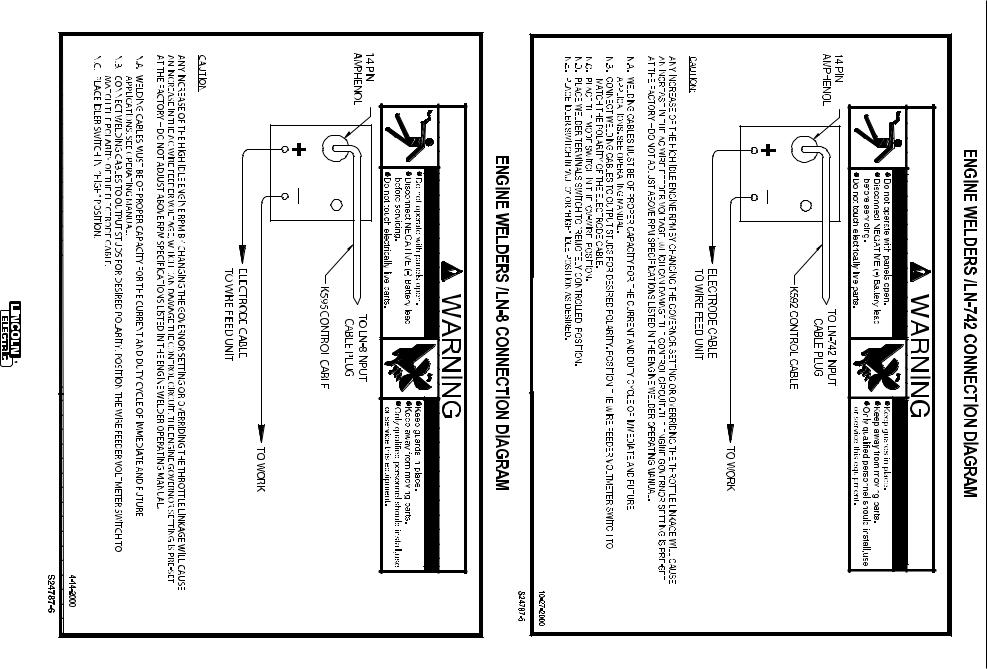
Return to Section TOC |
Return to Section TOC |
Return to Section TOC |
Return to Section TOC |
|
|
|
|
Return to Master TOC |
Return to Master TOC |
Return to Master TOC |
Return to Master TOC |
|
|
|
|
|
|
|
5-C |
400 VANTAGE® |
ACCESSORIES |
5-C
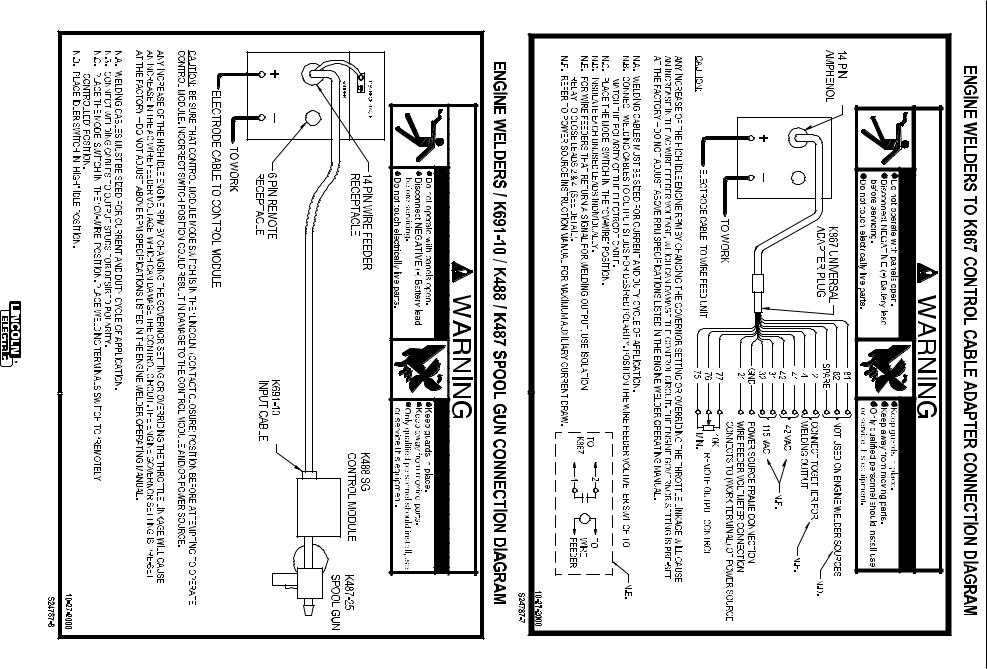
Return to Section TOC |
Return to Section TOC |
Return to Section TOC |
Return to Section TOC |
|
|
|
|
Return to Master TOC |
Return to Master TOC |
Return to Master TOC |
Return to Master TOC |
|
|
|
|
400 VANTAGE® |
6-C |
ACCESSORIES |
6-C |
